

Visiting Herculaneum: 13 Top Attractions
Written by Barbara Radcliffe Rogers Updated Dec 27, 2023 We may earn a commission from affiliate links ( )
Destroyed in AD 79 by the same eruption of Mt. Vesuvius that engulfed Pompeii, Herculaneum was buried in molten lava, instead of the ash that covered Pompeii. The town of about 6,000 people lay for centuries encased in a solid mass of pumice and ash to a depth of 12 to 30 meters.
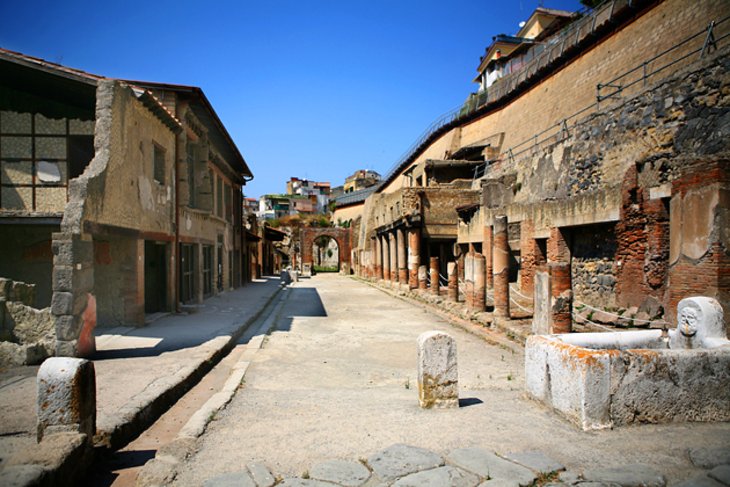
This hard, deep covering formed an airtight seal that protected it from plunderers and even from early excavation methods, saving artifacts and priceless details that have been lost at Pompeii. And unlike Pompeii, all but the very first finds and artworks have been left in their original places, not stripped for transport to off-site museums, adding to the experience of visiting Herculaneum.
In addition, instead of a sudden weight of falling ash that crushed roofs and collapsed houses in Pompeii, the fast-flowing lava filled Herculaneum from the ground up, supporting walls and roofs as it encased them. This preserved its multi-storied homes, complete with doors and staircases, as well as a wealth of organic material missing in Pompeii.
Wooden furniture, textiles, and even food and skeletons tell us much about everyday life here, and its vivid frescoes and mosaics remain intact. For these reasons, and because the site is smaller, less crowded, and the attractions are easier to explore, many tourists find visiting Herculaneum more interesting than Pompeii . The two ancient cities can be combined on a day tour from Naples , or Herculaneum is easily reached on a half-day trip from Sorrento .
See also: Where to Stay near Herculaneum
1. Casa dell'Albergo (Inn)
2. house of galba, 3. sacello degli augustali, 4. thermae (baths), 5. samnite house, 6. casa del tramezzo de legno (house of the wooden partition), 7. house of the neptune mosaic, 8. house of the bicentenary, 9. palaestra and shops, 10. house of the deer, 11. house of the relief of telephus, 12. suburban baths (terme suburbane), 13. the fornici, where to stay near herculaneum for sightseeing, tips & tactics: how to make the most of your visit to herculaneum.
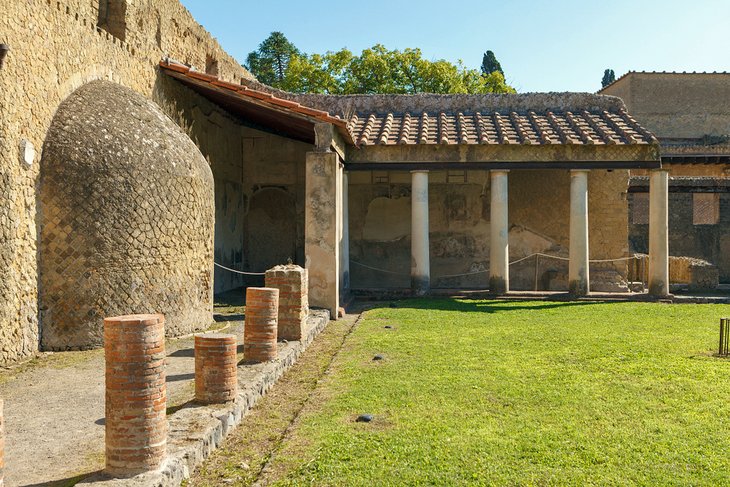
At the south end of Cardo III, which runs through an area excavated in the 19th century, Casa dell'Albergo filled almost an entire block. From the lines of columns that were once in its atrium, you can get a sense of the original size of this patrician house that was made into an inn.
Facing it on the other side of the street are the House of Aristides , a sumptuous country villa, and the House of Argus , with wall paintings and a garden with pillars. Farther along on the left is the House of the Genius, a fine patrician mansion with a garden enclosed by colonnades. Beyond the inn is the House of the Skeleton , with both wall paintings and mosaics.
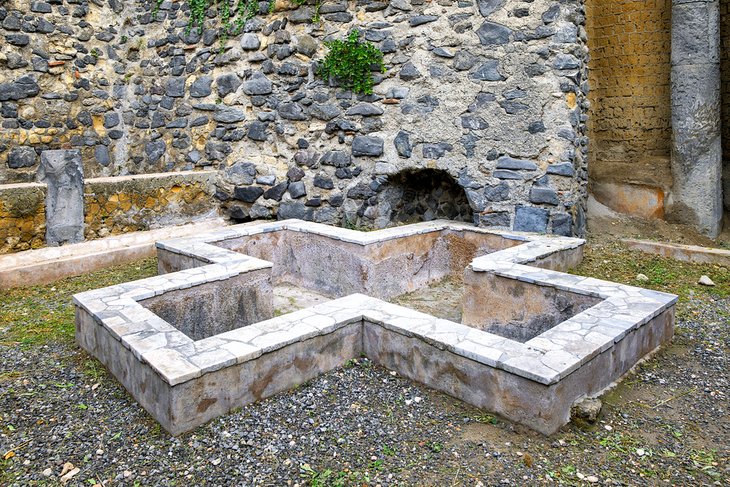
Halfway along Cardo III, the street is crossed by the Decumanus Inferior, beyond which is the House of Galba, on the left. Another fine patrician mansion, this one is interesting for its peristyle, which has a pool in the shape of a cross.
It might have been a reservoir, an ornamental fish pond, or intended for bathing, but it is unique in its shape. The area's original Doric columns were later covered in stucco. Beyond this house are more residences that are still unexcavated.
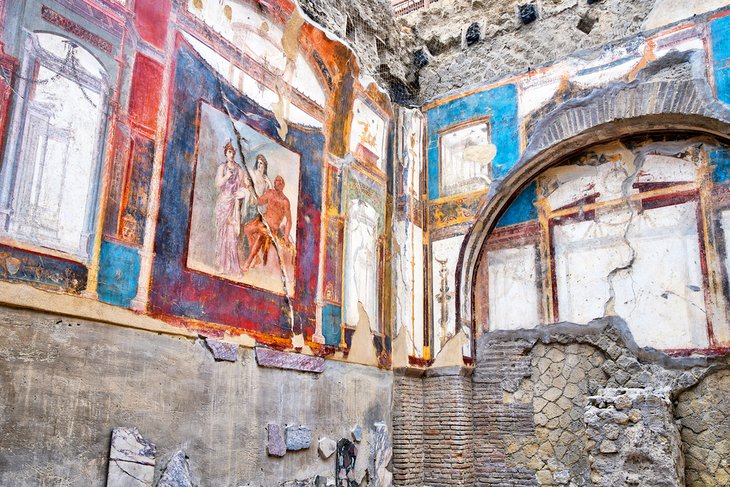
On the opposite side of Cardo III, at the end, the Sacello degli Augustali is a very large square shrine lit by an opening in the roof. It was originally dedicated to Hercules, patron of Herculaneum, for whom the town was named. It was later consecrated to the Imperial cult of Augustali, priests dedicated to the first Roman Emperor, Octavian Augustus, who was proclaimed a god after his death.
It has excellent frescoes, especially the one showing Hercules in Olympus with Juno and Minerva. Another shows Hercules fighting an Etruscan god.
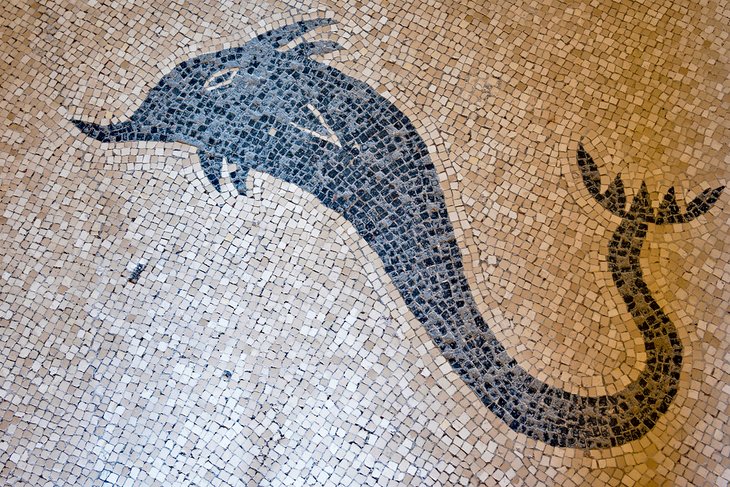
Among the more recent excavations along the Decumanus Inferior, on the left, are the well-preserved thermal baths, with separate sections for men and women. The men's domed frigidarium has a floor mosaic of dolphins, and the women's tepidarium floor, also in excellent condition, has a geometric pattern. Some of the wooden shelves are intact, as well.
Opposite the baths, across the Decumanus Inferior is the Cloth-Merchant's Shop , with a restored wooden press.
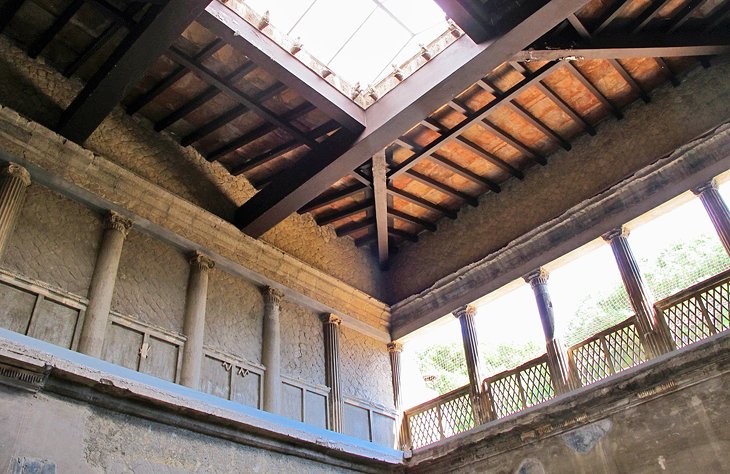
At the corner of the Decumanus Inferior and Cardo IV is the Samnite House, one of the oldest patrician mansions in the town. It was built in the second century BC, making it about 300 years old at the time of the eruption. The beautiful atrium is in the Greek style, with dramatic frescoes and a gallery lined by Ionic columns.
The atrium floors are of cocciopesto, a lime plaster mixed with ground terra-cotta, and there is a marble pool to catch rainwater. Throughout the house are rich stucco and fresco decoration. Be sure to look up to see the delicately carved tufa capitals.
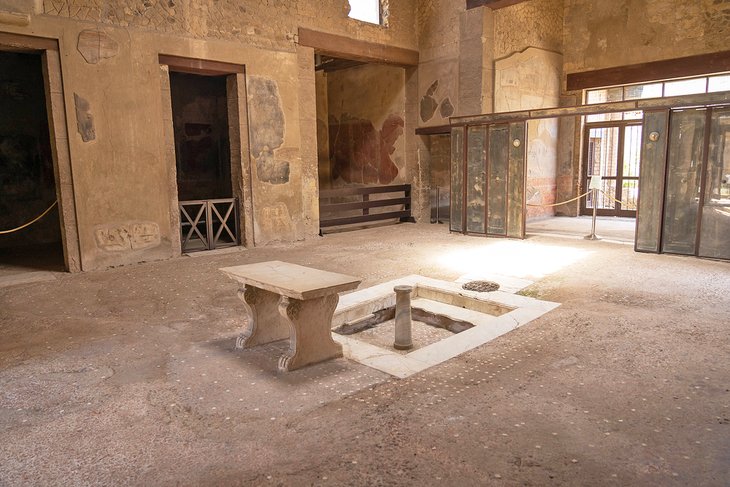
Diagonally across from the Samnite House is the House of the Wooden Partition , a patrician house of Samnite type but without a peristyle or colonnaded court. The name derives from the wooden partition that was still standing after the eruption.
The folding partition formed a wall of several hinged panels with brass handles, and was designed to give the bedrooms some privacy from the rest of the house. The bedrooms still contain bedsteads and a wooden chest. In the center of the central room is a small fountain with a marble bench.
The adjoining Casa a Graticcio was a more modest house with interior walls of wattle.
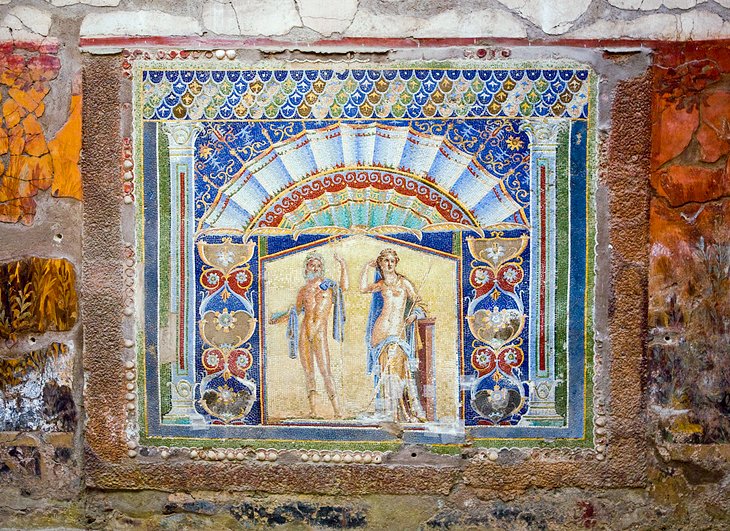
Farther up Cardo IV, on the other side of Decumanus Inferior, past the House of the Charred Furniture , is the House of the Neptune Mosaic. It is named for the well-preserved glass wall mosaic of Neptune and Amphitrite, one of a number of beautiful mosaics in this house, which evidently belonged to a wealthy family.
At the rear of the house is a courtyard with a nymphaeum, a grotto-like alcove with a fountain. On the wall beside the nymphaeum is the well-preserved mosaic of Neptune and Amphitrite, in vivid colors.
On the Decumanus Maximus, which parallels the Decumanus Inferior on the north and is still only partly excavated, the House of the Bicentenary contains one of Herculaneum's most fascinating mysteries. Stucco on a wall shows clear evidence of having once held a wooden Christian cross .
As St. Paul is known to have preached nearby, it is thought that this might have been a meeting place for early converts. If so, it may be the oldest known Christian cross. The house derives its name from the fact that it was uncovered in 1938, 200 years after excavations were started.
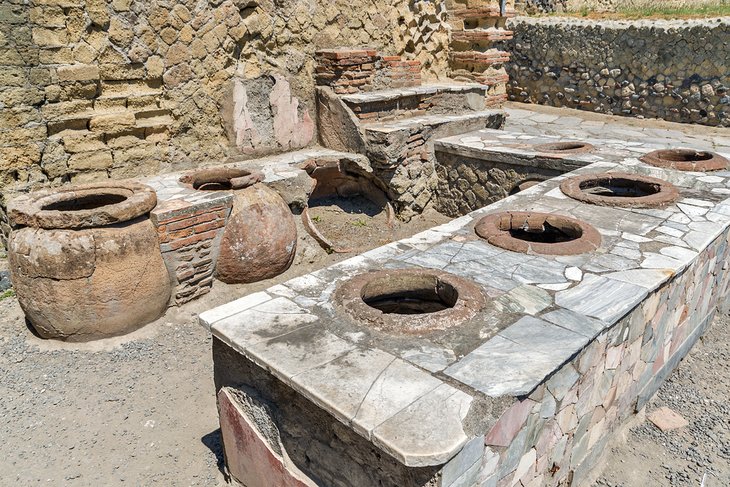
At the end of the Decumanus Maximus, Cardo V leads back past a series of shops, including a weaver's shop with looms; a dye shop with dye pots; and a bakery, in whose yard are ovens and mills for grinding grains. Also found here were bronze baking pans used for making flat bread. Along this street were a number of food shops, in which excavations turned up containers filled with walnuts and chickpeas.
The large area behind these shops was the Palaestra, a public field for games and other events.
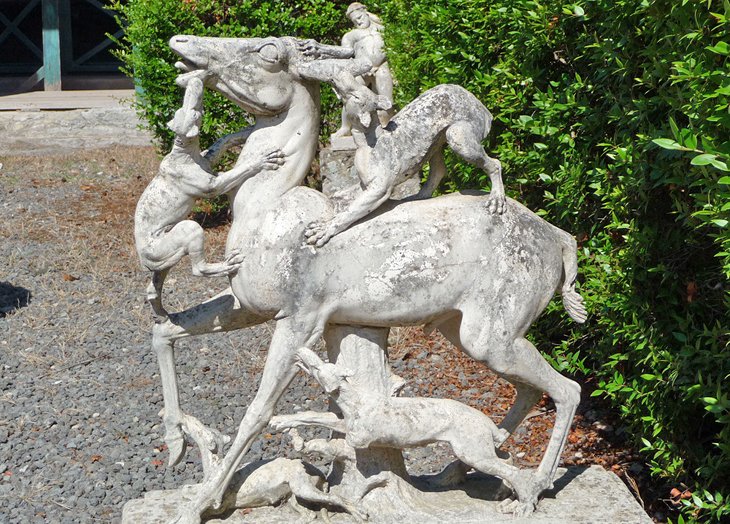
At the southern end of Cardo V, the House of the Deer was another luxury villa, with two stories built around a central courtyard. Notice especially its marble-chip and mosaic floors and frescoed walls. In the large garden, marble tables and deer statues were found, which are now preserved in the on-site museum. Marble replicas of those and other statues that were found here are displayed in the house.
Next to it is the House of the Mosaic Atrium , a spacious home with an unusual room divided into three naves, like a cathedral, the only one of its kind found here.
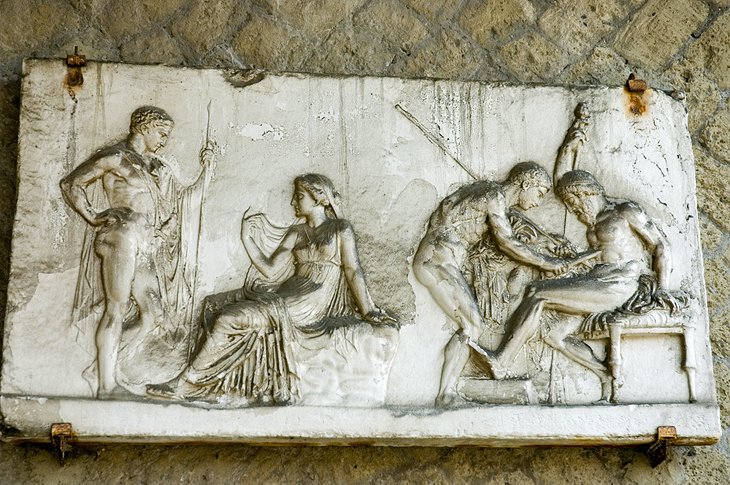
Opposite the House of the Deer, the House of the Relief of Telephus is one of the most elegant mansions in Herculaneum. In its spacious colonnaded atrium is a marble basin and a colonnade leading into the park, which sloped down to the marina.
The columns in the atrium support the upper floor of the three-story house. The original marble masks that hung between the columns have been replaced by cast replicas. The house is named for the marble relief, a finely worked piece in excellent condition.
At the edge of town near the ancient beach, the Suburban Baths are among the best preserved. Smaller than the central baths, they do not have twin facilities for men and women, so were either co-ed or used at different times.
The slate, mosaic, and marble floors; wall frescoes; and fountains are in good condition, although you can see some damage that was done by the force of the lava pouring in through the window. The House of the Gem , next to the baths, is beautifully painted in reddish-brown tones.
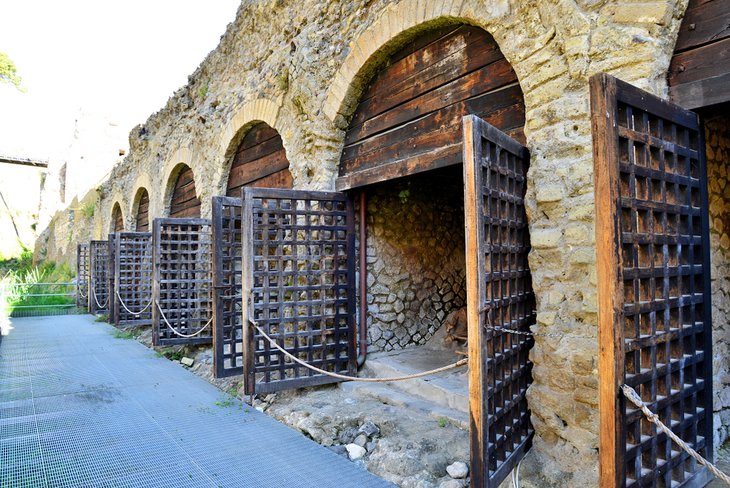
It was long believed that unlike Pompeii, Herculaneum's residents had escaped, as few human remains were evident in the town. But in 1982, further excavations at the port uncovered the skeletons of 300 people who had fled the city only to be incinerated by the sudden blast of extreme heat.
Perhaps the most dramatic sight in Herculaneum is at the Fornici, the warehouses at the port where boats were also kept. Fleeing the eruption, Herculaneum residents rushed here hoping to escape by boat, only to be enveloped by clouds of toxic smoke and volcanic ash before they could get away.
Along with the human skeletons, the Fornici excavations found the treasures these people hoped to save, including jewelry and coins, and a Roman ship nine meters long was found.
- Il San Cristoforo : Although it's a bit out of the center, this top-rated hotel offers a free scheduled shuttle to the railway station and archaeological site. The advantages of staying in this location are the spacious park-like grounds and gardens that surround the modern hotel, and the views of Mt. Vesuvius from some of the luxurious rooms. Breakfast and parking are free and there is a swimming pool.
- Andris Hotel : Also out of town and in the same price range, Andris Hotel is convenient if you're traveling by car. The peaceful location has views of Mt. Vesuvius, and rooms are spacious.
- Hotel Villa Signorini : In the same moderate price range , and a five-minute walk from the archaeological site, Hotel Villa Signorini occupies an 18th-century villa with an old-world atmosphere; breakfast and parking are both included.
- Hotel Herculaneum : This budget-friendly hotel is opposite the archaeological site and close to several restaurants. An excellent breakfast is included, and there are family-sized rooms. It's a five-minute walk from the train station.
- Ruins B&B : Sharing a reception area in a convenient location with the Hotel Herculaneum, Ruins B&B has budget-wise rooms , some with private terraces. Directly opposite the gates of the ruins, it is also at the stop for the minibus to Mt. Vesuvius. Breakfast is included.
- Tours of Herculaneum: A four-hour Herculaneum Tour from Sorrento provides round-trip transport by air-conditioned coach from your hotel in Sorrento and a tour of the ancient city led by an expert local guide. The two ancient cities can be combined on an eight-hour Pompeii and Herculaneum Day Trip from Naples , which includes round-trip transportation, a guided tour of Pompeii, a typical Italian lunch, and plenty of time to explore Herculaneum.
- For Your Comfort: Although there are quite a number of houses and other buildings to see in Herculaneum, these are much closer together than at Pompeii. Even so, expect a lot of walking on rough surfaces. Comfortable shoes are highly recommended. You'll find luggage storage at the ticket office.
- Getting Here on Your Own: The Circumvesuviana trains connect Naples and Sorrento, with two stops in Herculaneum. The Ercolano Scavi stop is a 10-minute walk from the entrance to the excavated area. There are shuttle buses, but unless there is a bus just loading, it's usually faster to walk.
- Address: Corso Resina, Ercolano NA, Italy
More Related Articles on PlanetWare.com
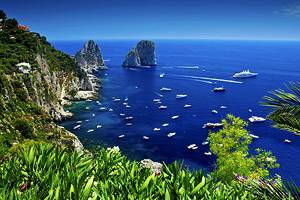
Where to Go from Herculaneum: Just a short drive or train ride away, the lovely town of Sorrento makes a good base for taking a ferry to the lovely island of Capri . It's also a good starting point for seeing the attractions of the Amalfi Coast .
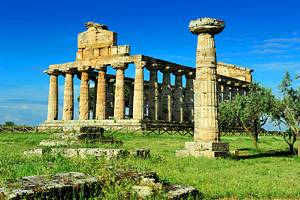
Exploring More Ancient Cities: If Herculaneum whets your appetite for more sites of the ancient world, begin with the other city destroyed by the eruption of Vesuvius in AD 79, using our page on Visiting Pompeii as a guide to the top sights. Not far south of the Amalfi Coast on the Gulf of Salerno are the well-preserved remains of the Greek city of Paestum , later occupied for 1,000 years by the Romans.
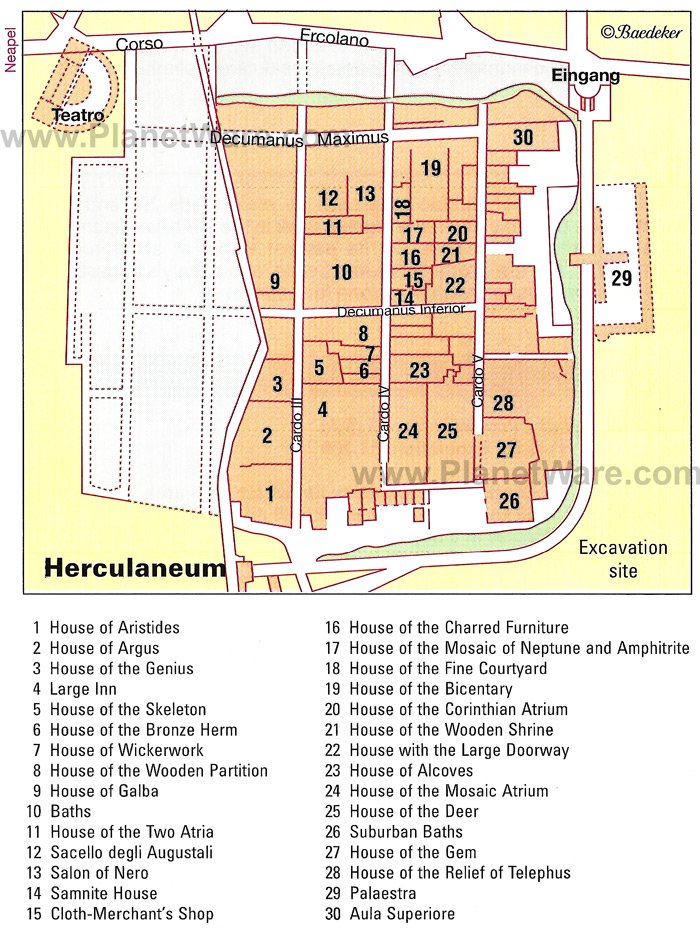
More on Italy


How to visit Herculaneum (and 3 huge reasons why you should)
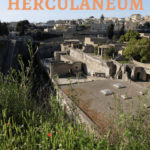
Visiting Herculaneum, a Roman city destroyed by the same volcano that engulfed Pompeii, is really rewarding. Here’s how to visit Herculaneum, and why it should be as much of a priority on your trip to Italy as seeing Pompeii.
Over 3.5 million people visit the ancient Roman city of Pompeii every year. Buried by tonnes of volcanic ash and rocks when Mount Vesuvius erupted in AD79, it’s one of the best-known tourist sites in Italy.
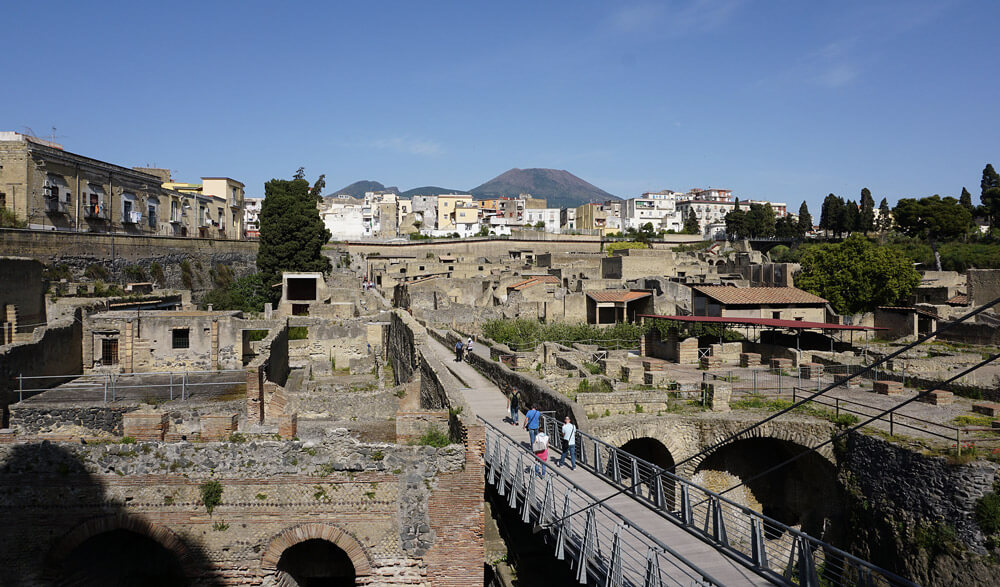
But there’s another Roman city just down the road from Pompeii that’s even better preserved and that receives only a tenth of the visitors that go to Pompeii. That city is Herculaneum, and it’s well worth a visit.
This post contains affiliate links – all this means is if you buy something as a result of clicking a link, I’ll make a small commission that helps me run this site. There’s no cost to you.
Where is Herculaneum?
Herculaneum, like Pompeii, was a Roman town on the coast of southern Italy, between modern-day Naples and Sorrento. You’ll find the ruins in the modern town of Ercolano. The ancient town actually extends underneath the modern one – what’s been excavated is probably only a small portion of what was covered when Vesuvius erupted .
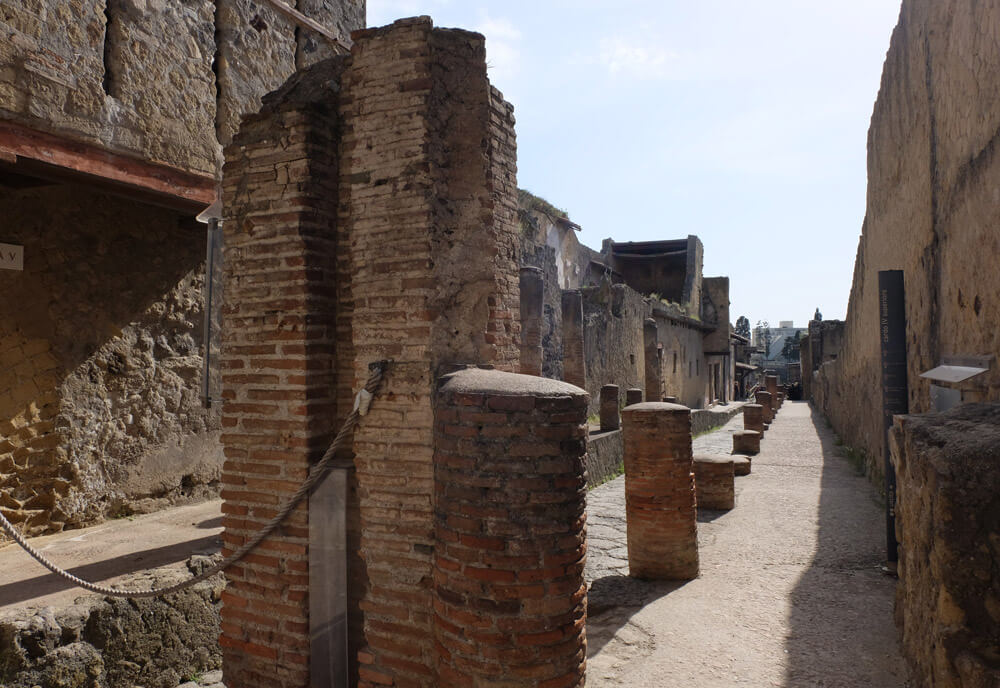
Herculaneum lies on the opposite side of Mount Vesuvius to Pompeii, and although they shared the same fate when the volcano erupted, they were destroyed in different ways; Pompeii by a 25-metre thick shower of falling rocks, Herculaneum by a lethal 100mph, 400°C pyroclastic surge of hot gas and ash.
Is it worth visiting Herculaneum?
I found Herculaneum just as fascinating as Pompeii. Here are some reasons why you should consider visiting Herculaneum.
Herculaneum is really different to Pompeii
The main reason to visit Herculaneum is because it’s so different to Pompeii. Don’t miss out on going to Herculaneum because you think it’s just a smaller version of Pompeii; it really isn’t.
Herculaneum is much better preserved than Pompeii
There’s a massive difference in the level of preservation at Herculaneum compared to Pompeii. When Mount Vesuvius erupted, the buildings in Pompeii were damaged by a deluge of falling rocks before being buried in lava and ash, meaning that very little survives above the ground floor, and virtually every building lost its roof.
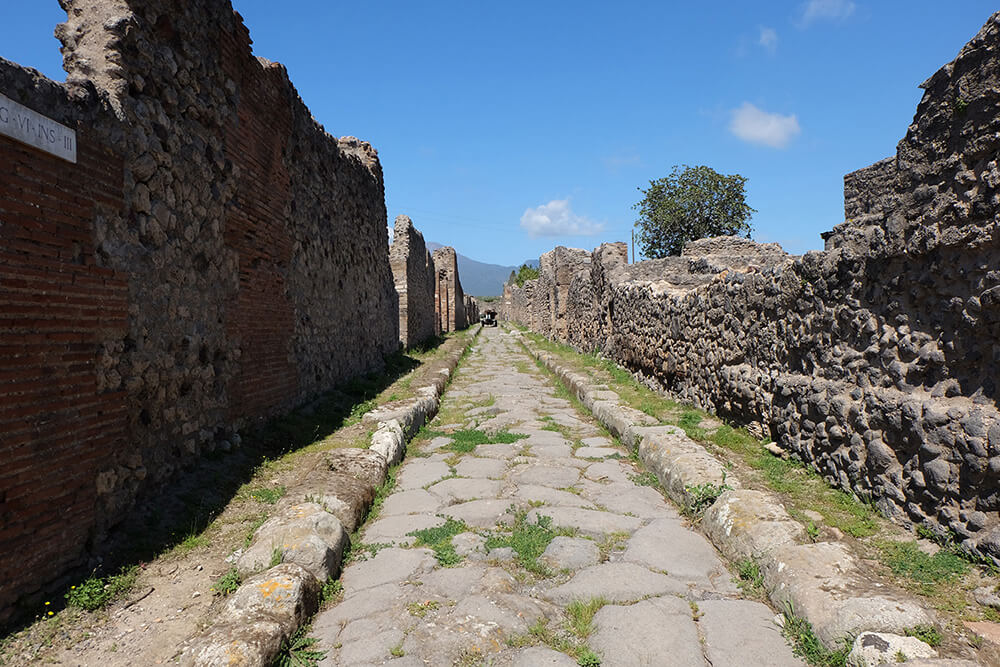
In Herculaneum, the town was buried almost instantly in hot ash. The buildings in Herculaneum are much better preserved than those in Pompeii; many of them have their upper floors still intact, and a couple even have their original wooden balcony. Unbelievably, some of the shops still have fittings.
Herculaneum was also a wealthier town than Pompeii, so many of the buildings you’ll see are more opulent and richly decorated. The mosaics and frescos are brighter, larger and more intricate here, a real treat for the eyes.
While you definitely can imagine yourself living in Pompeii as you walk its Roman streets, in Herculaneum the effect is really powerful. If you close your eyes, you can almost hear and sense the Roman life going on around you – it’s truly like a living museum.
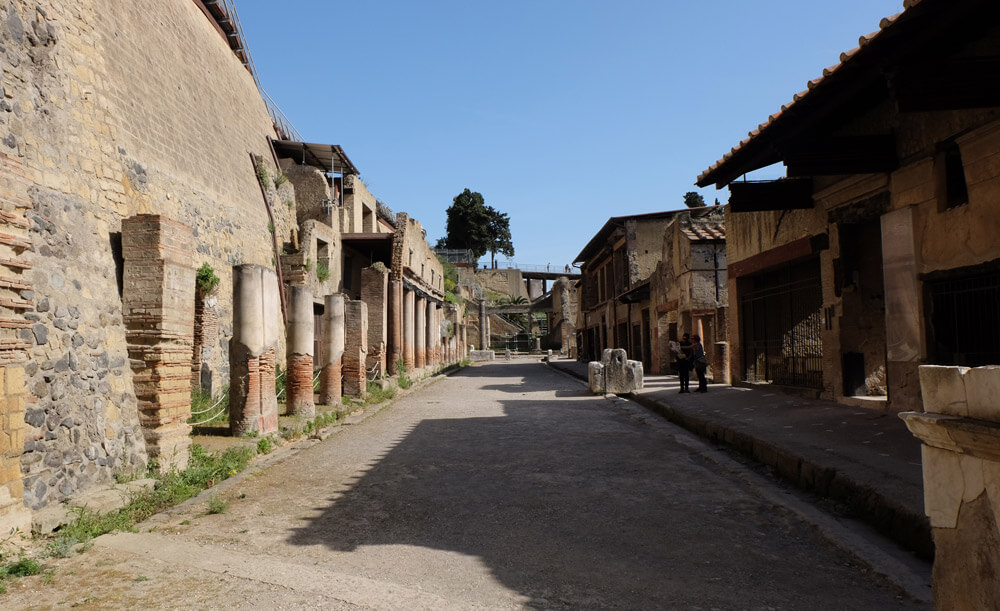
The fact that Herculaneum is better-preserved means that it’s much easier to make sense of how it worked as a town. In Pompeii it’s essential to take a guided tour to understand what you’re looking at; signs are few and far between and the grid layout makes it easy to get lost.
The excavated part of Herculaneum is far smaller than Pompeii, and each street has its own landmarks. The information signs and directions at Herculaneum are much better as well, and if you’ve taken a guided tour of Pompeii, there’ll be plenty that you’ll recognise from the other site.
Herculaneum is much smaller and quieter than Pompeii
Herculaneum gets around 300,000 visits a year compared to Pompeii’s 3.5 million, and while it is a much smaller site, the lower number of visitors gives it quite a tranquil feel. You won’t experience crowds at Herculaneum, or queues to see the most famous sights.
The sheer volume of hot ash which rained down on Herculaneum means that the modern town of Ercolano is at a much higher level than the ancient one, and as you walk down the long ramp into the ruins you’re surrounded by wild flowers and birdsong. It’s like stepping into another world.
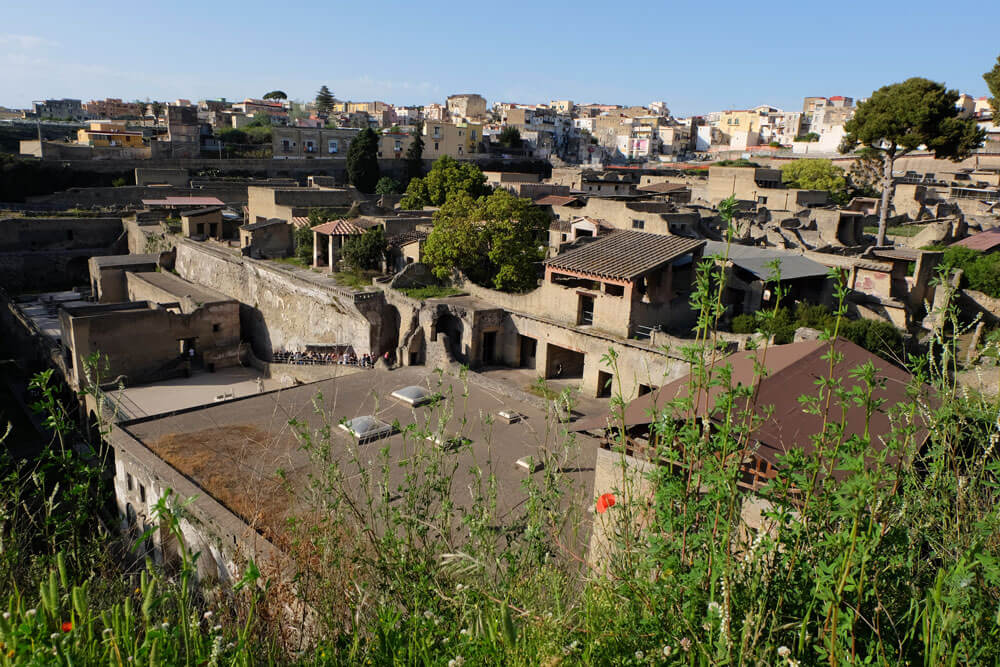
That tranquil feel, and the sense that the inhabitants have only just left, makes their deaths even more horrific. After you’ve seen the buildings where they lived, worked and socialised, you’ll reach the place where many of them died.
As you round the corner to the ancient beach (the eruption pushed the seafront 500m further out to sea) you’ll see the boathouses, and inside them, hundreds of skeletons. As these people sheltered in hope of being rescued by boat, an intense wave of hot gas hit the town. Until just a few years ago it was thought that they’d died instantly, their flesh vaporised. Unfortunately, more recent research suggests that they choked to death on the poisonous fumes as rising temperatures cooked their bodies.
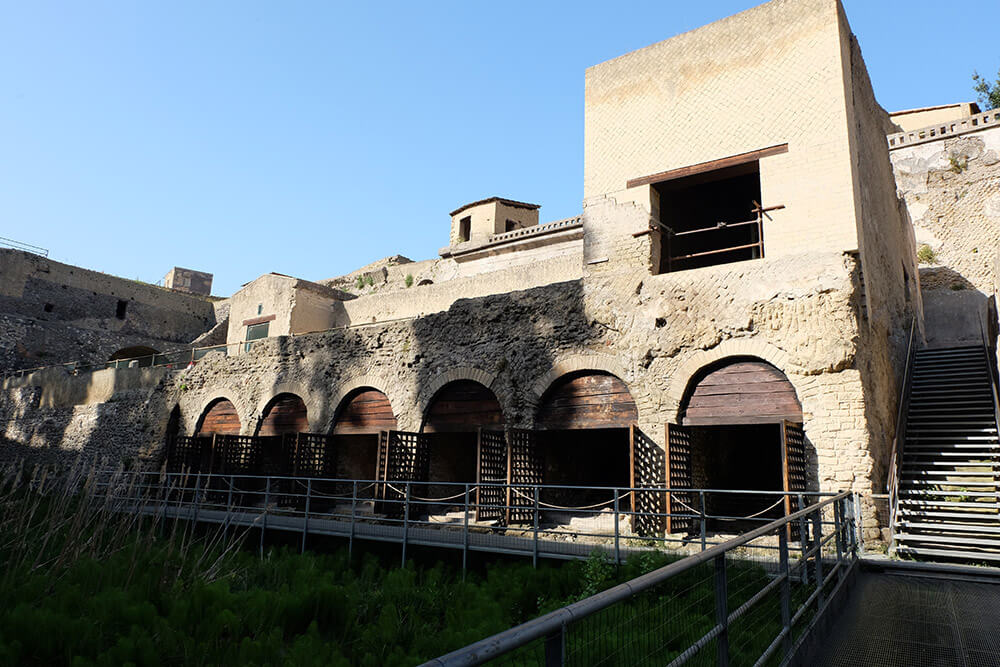
Which is better, Herculaneum or Pompeii?
It’s really difficult to choose between Herculaneum and Pompeii. If you’re interested in Roman history and what happened when Mount Vesuvius erupted, it’d be a real shame not to visit its most famous sight, Pompeii. Having said that, many people do prefer Herculaneum to Pompeii for its lack of crowds, stunning preservation and being able to see more sights in a shorter space of time with less walking.
If you’re determined to visit Pompeii, visiting Herculaneum as well adds a lot of extra richness to your trip, and it’s definitely worth visiting. It’ll give you a better understanding of what the buildings you saw in Pompeii would have looked like when they were complete, and a better feel for what the inhabitants’ lives were like.
The extra level of preservation at Herculaneum is absolutely amazing, and because it’s so close to Pompeii and so much smaller, it’s not too much extra effort to visit both. I do recommend visiting Pompeii before Herculaneum and taking a guided tour as it’ll help you understand both sites better.
Read more: Pompeii or Herculaneum – which site should I visit?
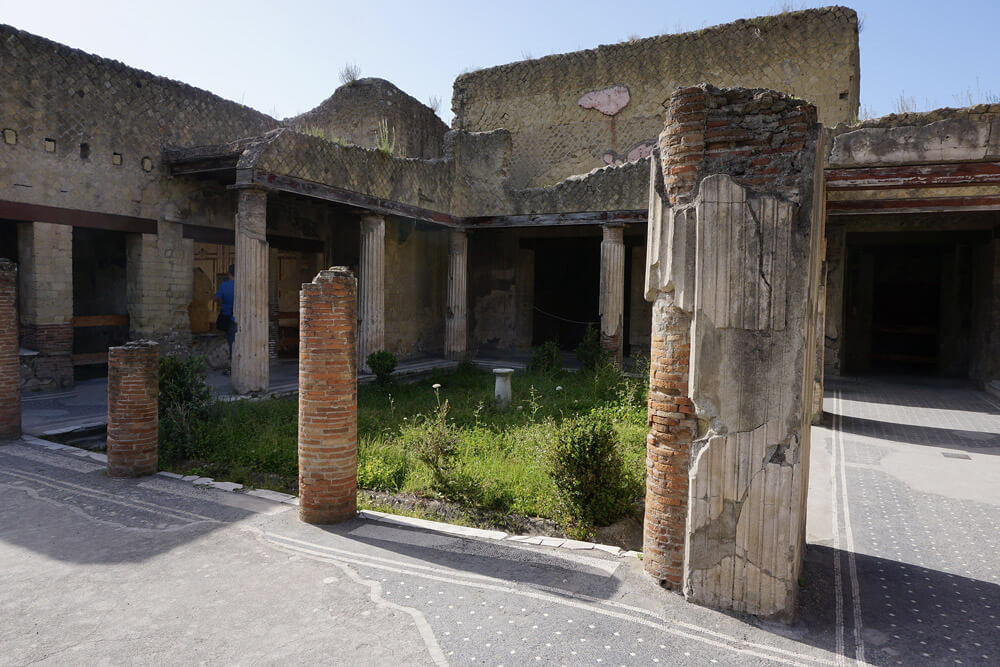
Can you see Pompeii and Herculaneum in one day?
It’s possible, but trying to visit both Pompeii and Herculaneum in one day would be exhausting. Pompeii is an enormous archaeological site, and visiting it is a lot like visiting a modern city, with the key sights spread out across the whole area. It’s definitely not a good idea to try and visit Herculaneum and Pompeii as a day trip from Rome – with the travel it’s just too much.
I also found visiting the two Roman cities where so many people died quite emotional; the casts of the bodies at Pompeii are really tragic, while the skeletons at Herculaneum are actually rather horrifying. I think visiting Herculaneum and Pompeii on the same day might be quite emotionally, as well as physically tiring.
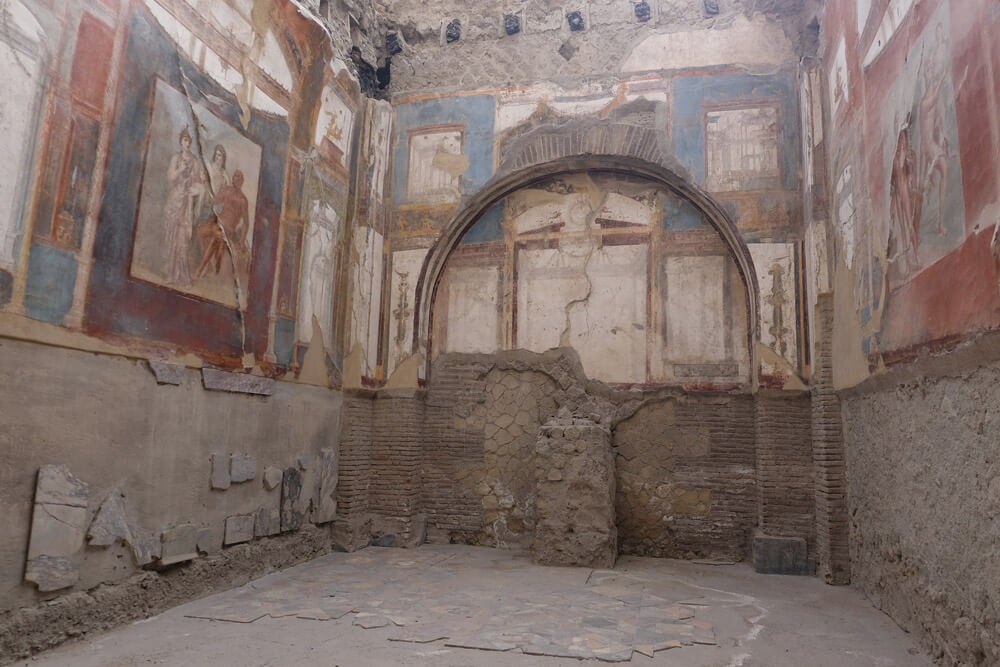
My recommended option for visiting Pompeii and Herculaneum is to first spend one full day at Pompeii, taking one of the official guided tours, then spend another day visiting Herculaneum and the crater at the top of Vesuvius. I spent around 3 hours at Herculaneum, leaving plenty of time to climb Vesuvius.
Getting to Mount Vesuvius from Herculaneum
Climbing Vesuvius is really easy from Ercolano (modern Herculaneum). Vesuvio Express buses leave from outside Ercolano train station (the same station that you’ll use to get the Circumvesuviana train to and from Naples and Sorrento) and take you up to the car park nearest the crater.
The buses depart at regular intervals, and give you around 90 minutes at the volcano – enough time to walk up to the crater, take a look around, and walk down again. A round trip transfer ticket is 12 euro per person, or 30 euro including a ticket for the hike up to the crater.
Read my tips for climbing Vesuvius
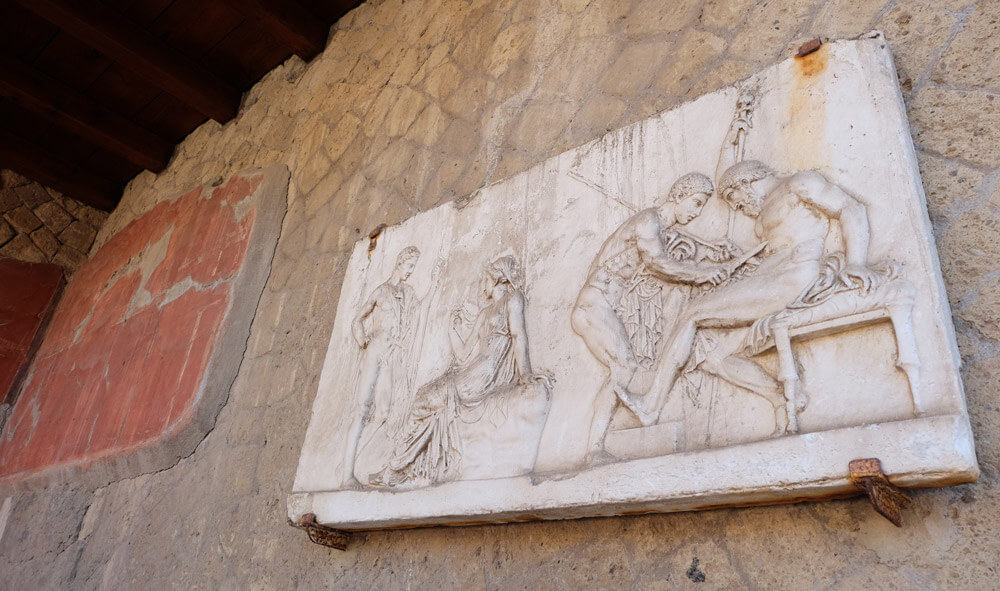
More things to do in Herculaneum (Ercolano)
Away from the main excavated site at Herculaneum, there are a couple of other interesting things to see when you go to Ercolano.
The MAV Virtual Archaeology Museum uses technology to bring the Roman cities of Pompeii and Herculaneum back to life. Through a series of interactive exhibits you can experience Roman life as it was just before the eruption. It’s an interesting way to get a different perspective on the ruins. It’s open 10am to 4pm, Tuesday to Sunday.
The Theatre of Herculaneum was the first trace of ancient Herculaneum to be rediscovered. In 1710, a man named Ambrogio Nocerino was digging a well and came across a 2,500-seat Roman theatre by accident. His find led to work starting on the excavations that we see today, but the theatre he found is still 20 metres underground, covered by the volcanic ash and accessible only by tunnels. It’s one of the best-preserved Roman theatres anywhere in the world.
Unfortunately, steep, dark tunnels and fragile historic buildings aren’t a great combination for a tourist attraction so it hasn’t generally been open to the public. However, the Theatre of Herculaneum did open in summer 2022 for an experimental series of guided tours. These didn’t happen in 2023 but the Ercolano website suggests that some dates will be announced for summer 2024.
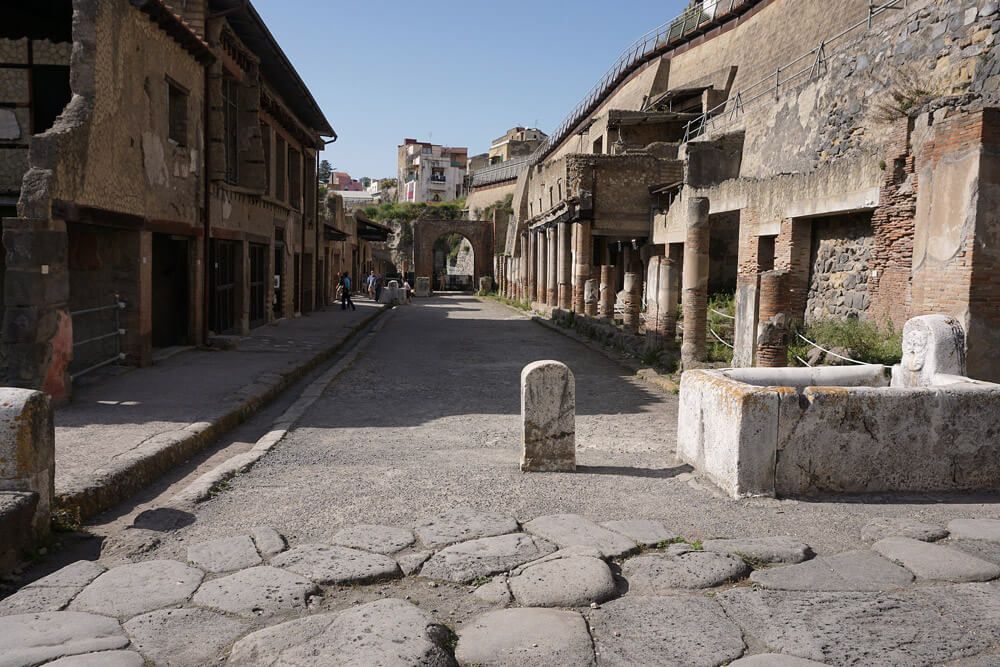
Practical advice for visiting Herculaneum in 2024
How to buy tickets for the herculaneum ruins.
Herculaneum is quieter than Pompeii and there’s usually no need to book tickets in advance. If you want to take a guided tour, I’d recommend booking that in advance as I didn’t see anyone offering tours on the spot like I did at Pompeii.
If you’re planning to go to Pompeii and Vesuvius as well as visiting Herculaneum, you can buy the Campania Artecard which will get you into both sites (plus a number of other sightseeing spots in the area) over the course of your visit.
There are five different versions of the Campania Artecard and it can get confusing comparing what’s included in each one, so I’ve put together a complete Campania Artecard review . I personally think that the Artecard Lite 365 is an absolute bargain if you’re spending a few days in the area.
Herculaneum opening hours
Summer hours for Herculaneum in 2024 are from 16 March to 14 October. In summer, the site is open from 8.30am to 7.30pm. The last admission is at 6pm, and visitors must leave the site by 7pm.
Winter opening hours start on 15 October 2024. For the winter period, the ruins at Herculaneum are open from 8.30am to 5pm, with the last admission at 3.30pm. Visitors must leave the archaeological area by 4.40pm.
It’s also closed on January 1st (New Year’s Day) and December 25th (Christmas Day). It’s free to visit Herculaneum on the first Sunday of the month, plus 25 April, 2 June and 4 November.
Please check these timings before your visit on the Herculaneum official website.
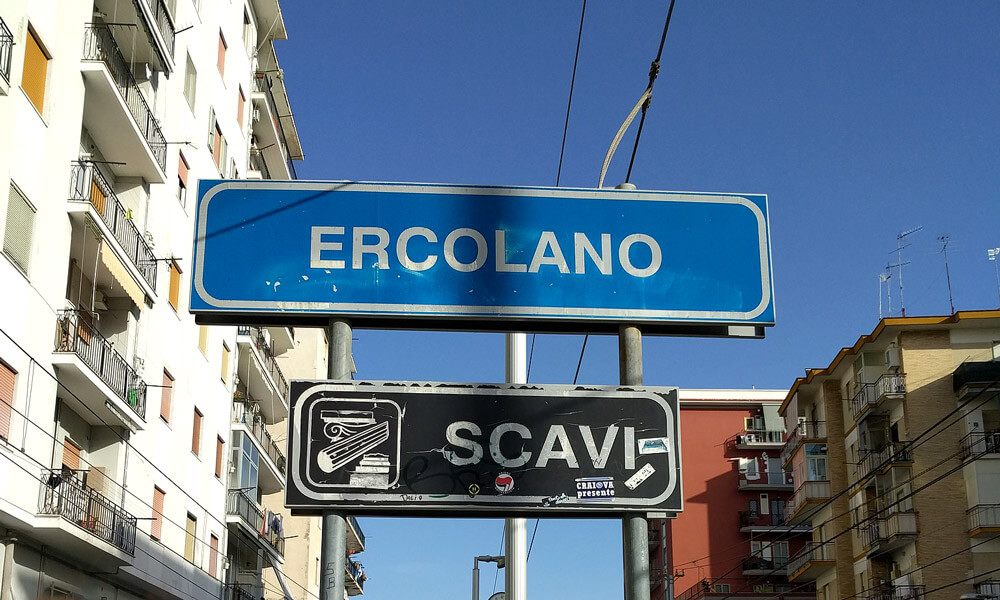
How to get to Herculaneum from Naples
The easiest way to visit Herculaneum from Naples is by taking the Circumvesuviana train from Napoli Centrale (Piazza Garibaldi) to Ercolano. The trains are a bit scruffy and get very crowded but run regularly. The Naples to Herculaneum train will take around 25 minutes.
To maximise your chances of getting a seat, try getting on at Porta Nolana station, one stop before Napoli Centrale. Get off at Ercolano Scavi station and walk straight down the hill towards the ruins. The walk from the station to the Herculaneum ticket office takes around 10 minutes.
Visiting Herculaneum from Sorrento
The journey from Sorrento to Herculaneum is another really easy trip on the Circumvesuviana train. Get on the train at the station in the centre of Sorrento and get off at Ercolano Scavi. The train from Sorrento to Ercolano takes around 40 minutes; at peak times there’s a train every 15 minutes.
When you get off the train, walk down Via IV Novembre towards the sea – the route to the Herculaneum ruins is reasonably well-signposted so you can’t go wrong. There are a number of shops, cafes and restaurants on this street as well so it’s easy to stop for a drink or something to eat either before or after your visit.
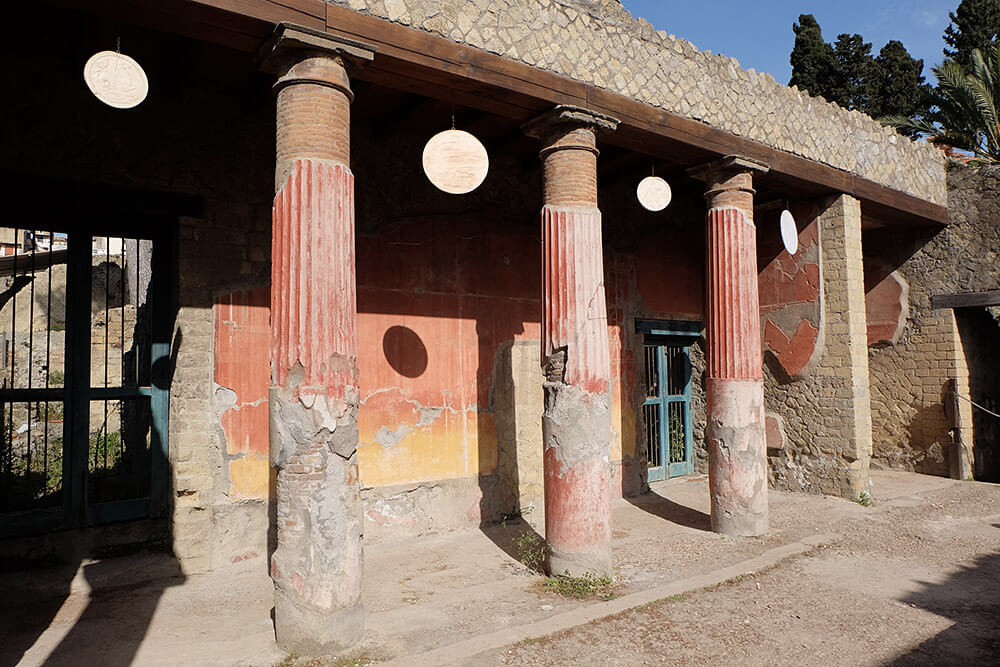
Can I take a guided tour of Herculaneum?
Guided tours are available at Herculaneum, but if you’ve done a tour at Pompeii and perhaps done some reading before your visit, I don’t think it’s essential – remember to pick up a paper map at the entrance though. Part of the reason for taking a guided tour at Pompeii is simply because of the scale of the site – there’s a really good chance that you’d get lost there without a guide!
At Herculaneum, the site is far smaller and the signage and explanations are also much better than at Pompeii. If you want a tour but you haven’t booked in advance, you can download the Ercolano app on Android phones, or you can hire an audio guide from the ticket office at the entrance.
Facilities at the Herculaneum archaeological site
The ticket office at the entrance to Herculaneum includes a small museum, toilets, luggage storage and a bookshop. There’s also a vending machine for food and drink near the entrance. There’s no restaurant or cafe on site but there are plenty of cafes nearby.
If you’re driving to Herculaneum there’s no official parking for the site but there are public car parks nearby.
Large bags (bigger than 35 x 30 x 15 cm) need to be left at the entrance but luggage storage is free.
Where to stay when you visit Herculaneum
The best places to stay when you visit Herculaneum and Pompeii are Naples or Sorrento . Modern Ercolano and Pompei might be geographically closer, but they’re both working towns, and apart from the ruins there’s not much else to do for visitors.
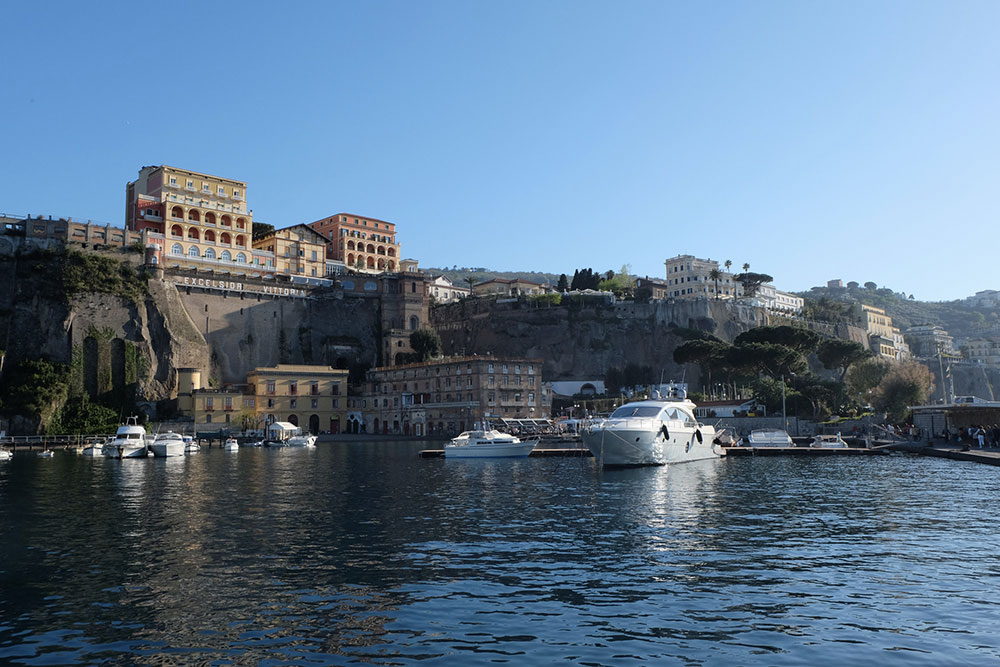
If you’re touring Italy and are short on time, stay in Naples. Naples has super-fast train services to Rome and other cities in Italy, and it also has an international airport. Naples definitely has a gritty reputation, but for convenience to get to and from Herculaneum and Pompeii, it can’t be beaten.
If you’re looking to build a relaxing vacation around your trip to Pompeii and Herculaneum, I’d recommend staying in Sorrento. Sorrento is at the end of the Circumvesuviana train line from Naples, which also stops at Pompeii and Herculaneum, making getting to both Roman sites really easy.
Read more about where to stay to visit Pompeii and Herculaneum
There are loads of things to do in Sorrento ; it’s a gorgeous town in its own right, and it’s particularly well-placed for day trips to Capri, Ischia , Procida and the Amalfi coast. Sorrento is also very welcoming for tourists, with a wide range of hotels, restaurants and bars, making it an easy, as well as scenic, option after long days spent exploring the Roman cities.
Related posts
If you enjoyed this post, you might find my other posts about places to visit near Naples useful:
- 12 tips for visiting the ancient Roman city Pompeii (plus how to climb Vesuvius)
- The best day trips from Sorrento
- The best places to stay to visit Pompeii
- The best things to do in Ischia
- How to get from Naples to Ischia by ferry
- Where to stay in Ischia – the best villages, beaches and hotels for every type of trip
- Visiting Ischia’s best thermal spa, Negombo
- How to visit Giardini la Mortella, a garden love story on Ischia
- Tips for visiting Castello Aragonese in Ischia Ponte
- Guide to visiting Procida, the tiny, beautiful island that’s a perfect day trip from Naples
- Amazing Roman ruins to visit
Would you visit Herculaneum?
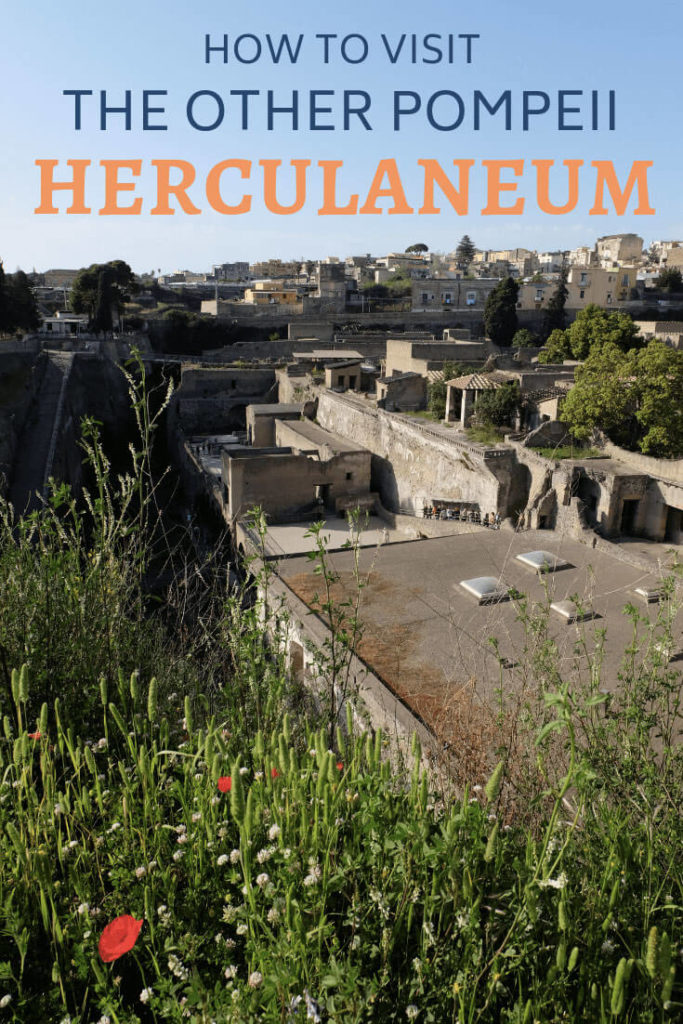
About Helen
Hi! I’m Helen , and Italy is one of my favourite destinations. I’ve been fascinated by ancient Roman and Greek history since I was a kid and I love nothing more than combining a visit to a Roman site with experiencing Italy’s beautiful landscapes and cities.
I live near Manchester, UK and work full time, so I’m all about making the most of my annual leave with day trips, weekend getaways and short breaks.
Save for later or share with a friend
20 thoughts on “How to visit Herculaneum (and 3 huge reasons why you should)”
Hi, I enjoyed visiting your site, very helpful, Can I ask you if you know if there is a ticket machine at Ercolano Scavi train station, Thanks
Hi Robert, glad you found it useful! I’m not sure as we bought return tickets from Sorrento to Ercolano, but I would think there would be a way to buy tickets.
thank so much for the informative post, I am planning a trip to Italy and never even knew about Herculaneum until I scrolled through your post about Pompeii and saw the following post Wow definitely on my list as I am over age 75 and know that I will be able to manage the smaller site
Thank you Heather, so glad it was helpful! If you do visit Pompeii then I’d recommend using the Porta Marina entrance as there’s a higher concentration of sights (the Forum, the arch of Nero, some temples and the Antiquarium museum) around that entrance compared to Piazza Anfiteatro which is closer to the large villas and the plaster casts at the Garden of the Fugitives. You might also want to look at the Pompeii for all route – it’s still 3.5km but it’s designed for wheelchairs so less tiring than walking on the uneven roads. I hope you have a wonderful trip to Italy!
This is actually really pretty, I didn’t know about this site. I’ve been looking for travel destinations for my wife’s birthday, and this looks like something she would enjoy much! We’ve been talking about Italy too, we’ll dedicate a day of our trip to visiting this ancient city. thank you!
Thanks David, hope you have a great trip!
Fascinating. We debated for a while when we were there as to which site to visit. We opted for Pompeii, and it was so crowded. After reading this, I am pretty sure for us, we made the wrong choice. If we ever get back, Herculaneum will be the top of our list
I don’t think there’s really a wrong choice as Pompeii is amazing, but I do really recommend a visit to Herculaneum 🙂
We went here a number of years ago instead of Pompeii. Very intense day. I think I’d like to go back and see Pompeii too. Herculaneum was quiet and hardly any crowds.
It’s amazing how quiet Herculaneum is isn’t it. I hope you get to see Pompeii too.
I just missed Herculaneum, arriving seconds after the ticket office shut and I was so cross with myself! I definitely want to get there soon. Your guide is super useful.
Oh no what a shame! I hope you manage to get back there and visit Herculaneum.
I love to explore historic sites and this place looks stunning. Thanks for the historic facts of how herculeam is differed from pompei. Will certainly visit this when I m in italy
Thanks Sinjana, if you’re into history then you’ll find both Herculaneum and Pompeii fascinating.
Thank you for this! I’m going to Naples later this year and am now thinking of adding Herculaneum to our itinerary!
I definitely recommend a visit to Herculaneum, it’s amazing to think of what else might be hidden underneath the modern town.
Couldn’t agree more that people should visit The Other Pompeii. Honestly, I never get tired of either one but agree that Herculaneum is a bit better preserved. Great post!
I do think people should go to both but then I love both so I would, haha. I think there’s lots of people for whom Herculaneum is a better option – Pompeii is amazing but it isn’t an easy place to visit if you’re not up for a ton of walking on those uneven roads and you’re not prepared to put a bit of work in to understand it. Herculaneum is a lot more accessible in every sense.
We plan to go back to Italy this year (Rome is my most favorite city in the world!), and I’ve always skipped Pompeii because of crowds. Thank you for this in-depth article about another, quieter option, as well as the suggestion to stay in Sorrento!
I visited Pompeii in April and honestly it wasn’t too bad. We got there mid morning and the key sights were busy but nothing that made our visit unpleasant. The site’s so big that if you step away from the main streets you can be on your own. However Herculaneum is significantly quieter and so interesting. I definitely recommend a visit!
Leave a comment Cancel reply
Save my name, email, and website in this browser for the next time I comment.
This site uses Akismet to reduce spam. Learn how your comment data is processed .
Matosinhos: the beach town with golden sand near Porto
11 fun day trips from manchester.
Herculaneum: The Complete Guide
How to Visit the Archaeological Site of Herculaneum, Italy
:max_bytes(150000):strip_icc():format(webp)/ElizabethHeath-Headshot-horiz-e7525e97616245958bf3d94e8db7f119.png)
Creative Commons CCO
Archaeological Park of Herculaneum
Herculaneum is an archeological zone located at the foot of Mount Vesuvius in the town of Ercolano in Southern Italy. Named after its patron deity, Herakleia (Hercules), the wealthy seaside town (along with its more famous neighbor, Pompeii) vanished beneath a sea of lava from a devastating volcanic eruption in AD 79.
History of Herculaneum
After falling under the control of the Greeks in the 5th century BC, Herculaneum became part of the Roman Empire around 89 BC. Once a bustling seaside resort, its existence came to an abrupt end on August 24, AD 79 with the explosion of Vesuvius. Unlike Pompeii, which was buried in volcanic ash, Herculaneum was buried in a deep layer of molten magma, which engulfed nearly everything in its path.
It wasn't until the 18th century that excavations uncovered a large number of Roman houses. Unlike Pompeii, where it's estimated that 2,000 people perished along with most of the wooden structures, the fast-moving pyroclastic material that covered Herculaneum left behind buildings and domestic items remarkably preserved. Not all the residents had time to flee; some 300 Roman skeleton remains have since been found here.
The most notable home to survive is Villa dei Papiri (House of Papyri), which was the inspiration for the J Paul Getty Museum in California. The restored villa contains frescoes, mosaics, and the skeleton of a horse. It is currently not open to the public.
Designated a UNESCO World Heritage Site in 1997, much of what we know about Roman daily life was gleaned from artifacts unearthed at Herculaneum. Considered to be the most revealing ancient ruins in all of Italy, you'll see many of the antiquities extracted from Herculaneum at the National Archeological Museum in nearby Naples.
What To See and Do in Herculaneum
Wander around the excavated area, popping in and out of houses and peering into ancient public spaces. Here are some of the highlights to see in Herculaneum.
Step Inside a Typical Roman Boarding House: The Trellis House ( Casa a Graticcio ) is an outstanding example of a typical Roman boarding house. The structure was built of opus craticium: a typical half-timber and mortar technique used at the time. Incredibly, household items such as wooden beds, wardrobes, and even a portrait remained, providing a glimpse into a day in the life of average Romans.
Witness Intricate Tiling at the House with the Mosaic Atrium: The Mosaic Atrium house is believed to have been inhabited by Roman aristocracy due to its elaborately decorated interiors and a million-dollar position facing the Bay of Naples. But it's the floor that is the thing: a black-and-white checkerboard mosaic motif that covers a grandiose atrium.
Marvel at the Sculptures at the House of the Stags: Named for the sculpted group of male deer found inside, The House of the Stags ( Casa dei Cervi ) is a fine example of how the "other half" lived. There's an inner porticoed garden, a formal dining room, several bedrooms, and a shady arbor sporting enviable sea views.
Get a Peek of a Nobleman's Digs at the House of the Bicentenary: Buried deep beneath the rubble, the House of the Bicentenary ( Casa del Bicentenario ) was unearthed more than 200 years after excavation of Herculaneum had begun (hence, its name).
Tour the House of the Gem: The two-story House of the Gem ( Casa della Gemma ) was named after a piece of cameo jewelry found there. The carved shell bore the engraved effigy of Livia, wife of the emperor Augustus, mother of emperor Tiberius, and grandmother of emperor Claudius. That's some family tree!
See an Ancient Infographic at the House of the Relief of Telephus: Casa del Rilievo di Telefo contains a 1st-century relief that narrates the mythical story of Achilles and Telephus.
Enter the Garden at the House of Neptune & Amphitrite: Inside this fashionable home is a garden court with the colorful portraits of Neptune and Amphitrite for which the house was named.
Imagine a "Spa Day" at the Central Baths: Constructed in the first half of the 1st century BC, the bath complex is divided into two distinct sections: one for men, which includes a heated swimming pool or "tepidarium" (a bath with an underfloor heating system). The other sector was for women: quite a bit smaller, but much better preserved.
How to Visit Herculaneum
Location: Corso Resina, 80056 Ercolano
Hours: Herculaneum is open April to October, 8:30 am to 7:30 pm (final entry 6 pm), and November to March, 8:30 am to 5:00 pm (final entry 3:30 pm). Closed January 1 and December 25. Check the website for updates.
Prices: Adult one-day tickets cost €11. Young adult EU Citizens between 18 and 25 years old can purchase a one-day ticket for €5.50.
Visiting Tips: Herculaneum is compact and therefore much easier to tour than Pompeii, and less crowded as well. It can be explored with a map and an audio guide. Be careful when moving about and do not stand on the edge of the digs or climb the walls.
How to Get There: If you're arriving by train (which we recommend), take the Circumvesuviana line from Naples to Herculaneum (Ercolano Scavi station). It's a short walk from the station to the park entrance. If you're driving, there are parking lots near the entrance.
Nearby Attractions
Pompeii . Located 10 miles south of Herculaneum, Pompeii was a thriving metropolis until its demise by the Vesuvius eruption of AD 79.
Oplontis & Stabiae. Oplontis is best known for its Roman Villa Poppaea, a UNESCO World Heritage Site, and Stabiae for its remains of both an Oscan settlement (oppidum) and the later Roman town.
Antiquarium of Boscoreale. Another casualty of Vesuvius's wrath, the town, and archeological area is located on the slopes of Vesuvius, just north of Pompeii where its fertile lands were resettled after the eruption.
National Archeological Museum . Located in Naples, see Roman treasures recovered from Herculaneum and Pompeii, as well as Greek art, and works from the Farnese Collection.
National Archaeology Museum of Naples
The 14 Best Day Trips from Rome
The Top 10 Day Trips from Naples, Italy
Visiting Ancient Pompeii: A Visitors Guide to the Excavations
Visit the Amalfi Coast of Italy
Paestum: Planning Your Visit
Roman Amphitheaters in Italy
The Top Museums in Naples, Italy
48 Hours in Athens: The Perfect Itinerary
Italy UNESCO World Heritage Sites - Southern Italy
22 Things to Do in Central Naples, Italy
Borghese Gallery: A Complete Guide
Top Roman Cities and Ancient Sites in France
The Top 23 Things to Do in Italy
Top 6 Tourist Attractions in Italy
The 25 Top Attractions in Rome, Italy

Herculaneum
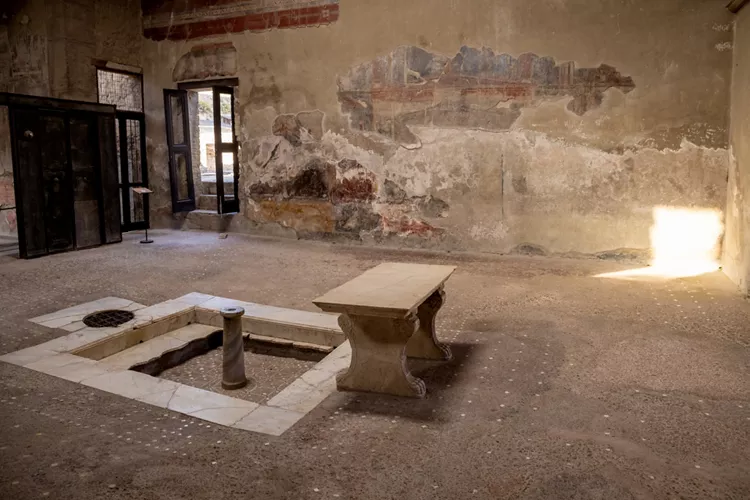
Herculaneum History, traditions and daily life
Herculaneum, together with Pompeii and Oplontis, is part of the UNESCO World Heritage Site and perfect testimony of life in a typical Roman city. Founded according to legend by Hercules, it was buried by the eruption of Vesuvius in 79 A.D. Herculaneum attracts a great many visitors every year to its succession of streets, villas, shops, spa buildings and places of worship. A place of memory that preserves a priceless cultural heritage, an example of a historical period characterized by its lifestyle and its daily life.
Full price 13 €
Reduced (young people 18-25) 2 €
Ticket Office
80056 Ercolano, Metropolitan City of Naples, Italy
Related articles
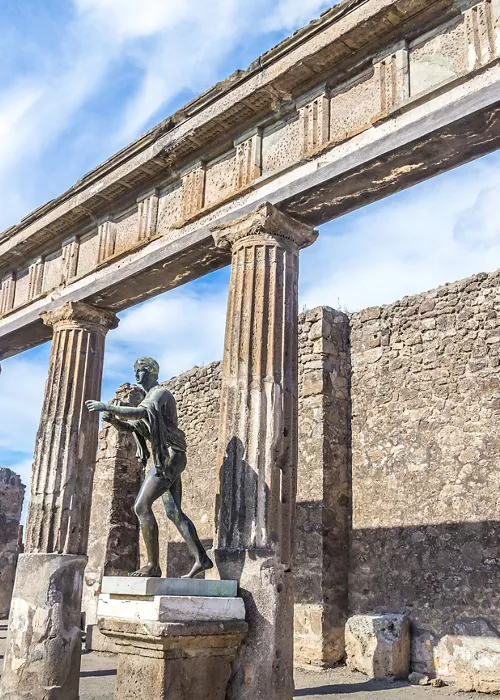
Discovering the archaeological area of Pompeii, Herculaneum and Torre Annunziata
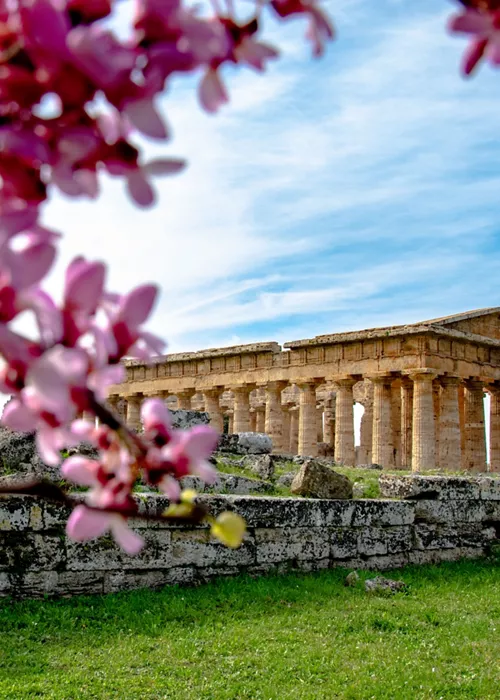
Cilento, between unspoilt beaches, wild nature and charming hamlets

The enchanting historic centre of Naples UNESCO World Heritage Site
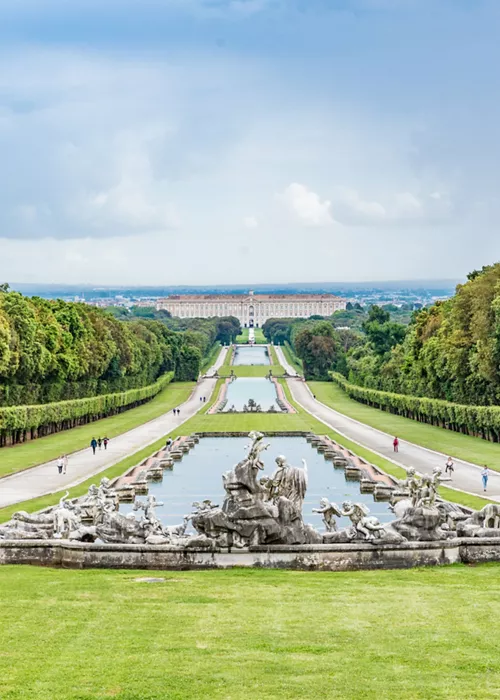
The Reggia of Caserta: sumptuous triumph of Italian Baroque
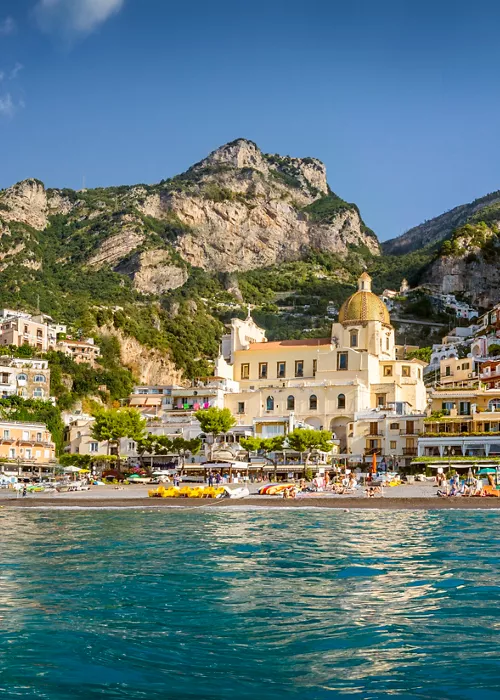
The Amalfi Coast: a hypnotic view of the cobalt blue sea
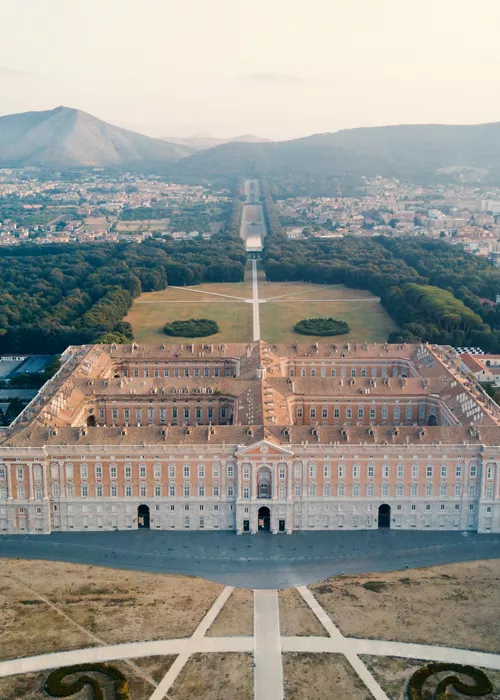
Naples-Caserta, travel like a king
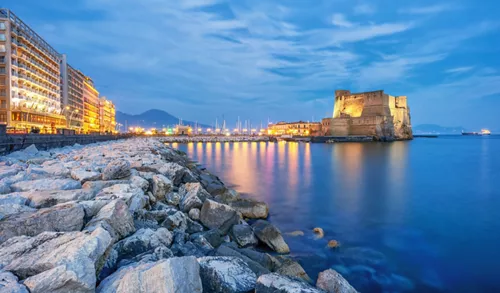
Naples, an enchanting city of sea and culture
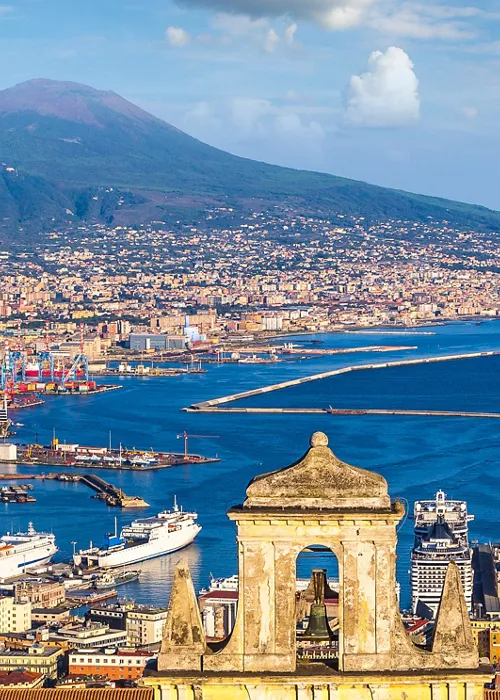
2 days in Naples: the itinerary
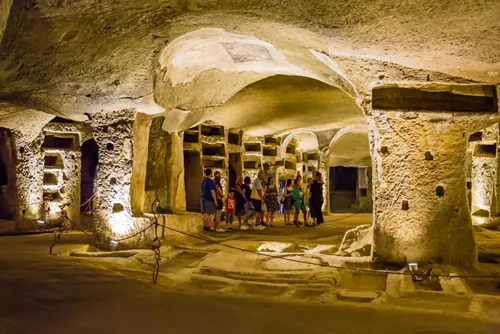
The Catacombs of Naples
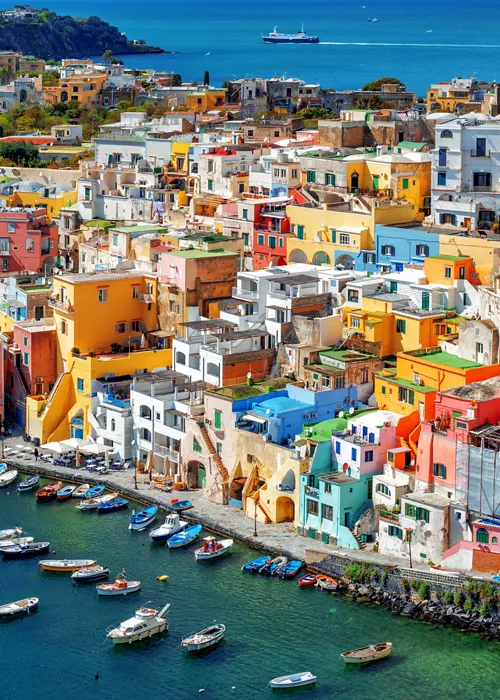
Procida: the enchanted island of watercolour houses and turquoise sea
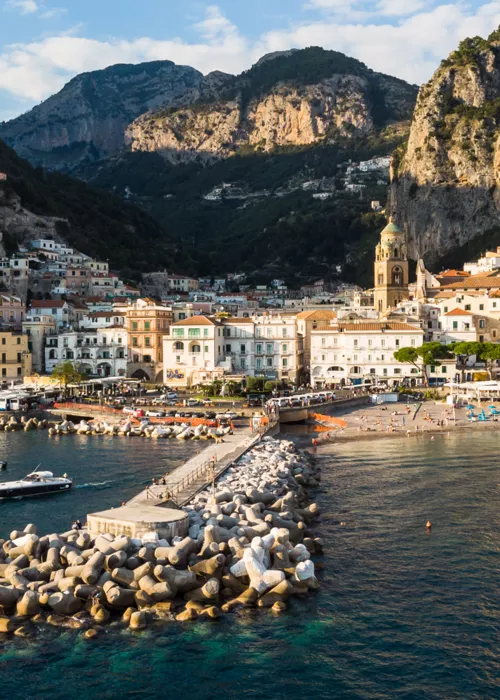
Campania: postcard-perfect sea and dizzying flavours
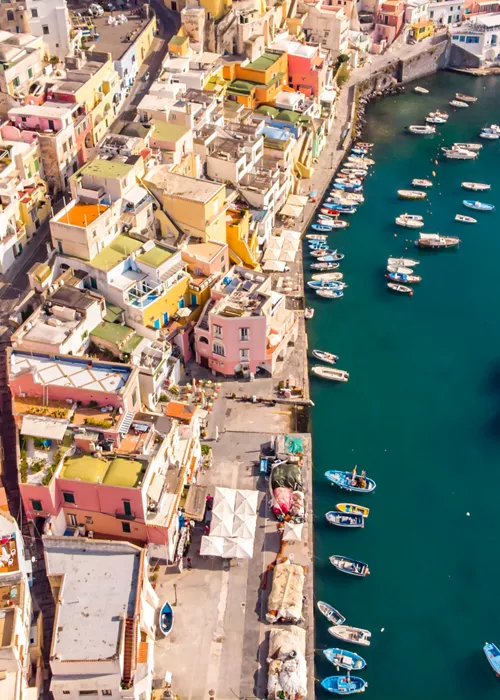
Procida: a crossroads of experiences for all the senses
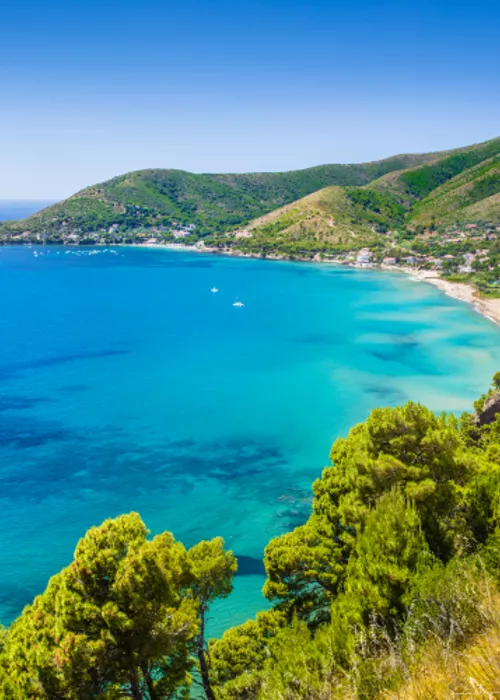
Campania Parks: sustainable tourism in the region's protected areas
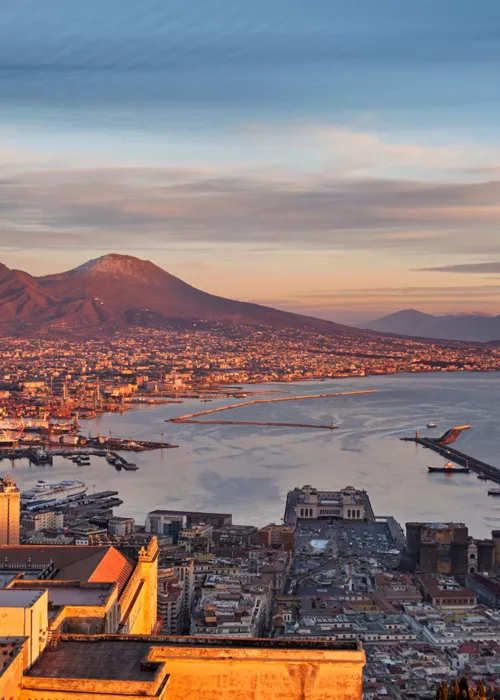
Travelling to the mountains from Naples: here's where to go
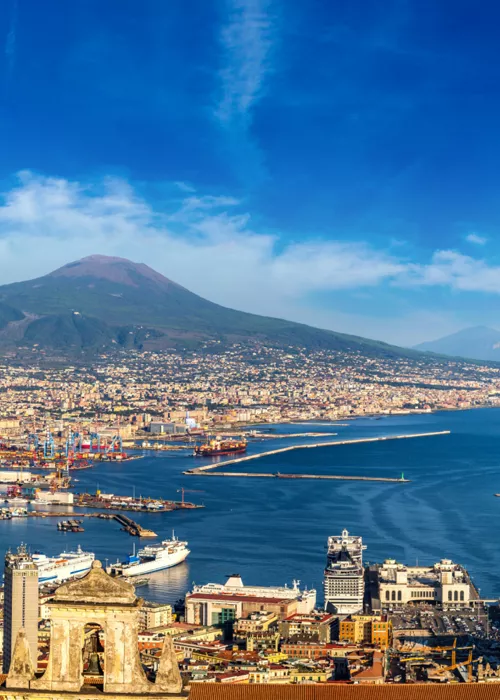
A 10.000-step itinerary around the centre of Naples
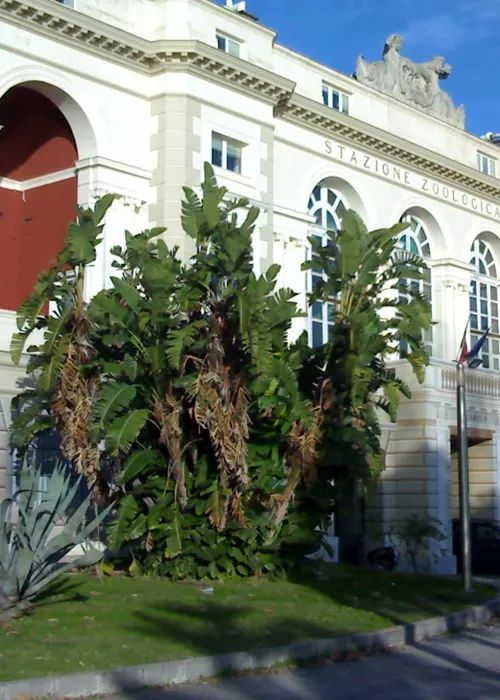
Anton Dohrn Zoological Station, the aquarium of Mare Nostrum
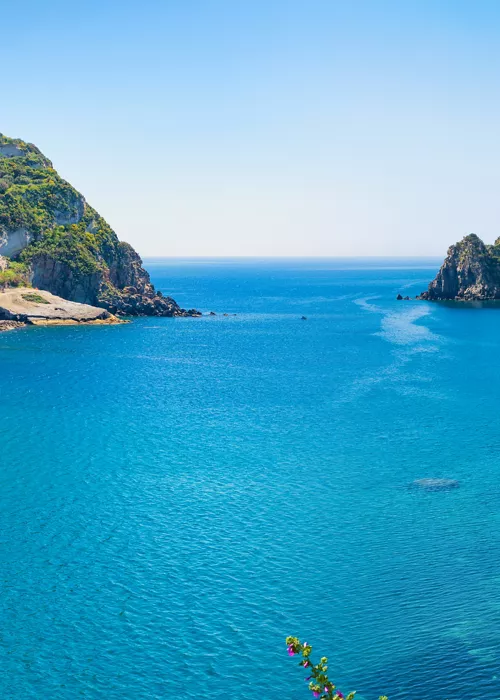
The Paths of Ischia
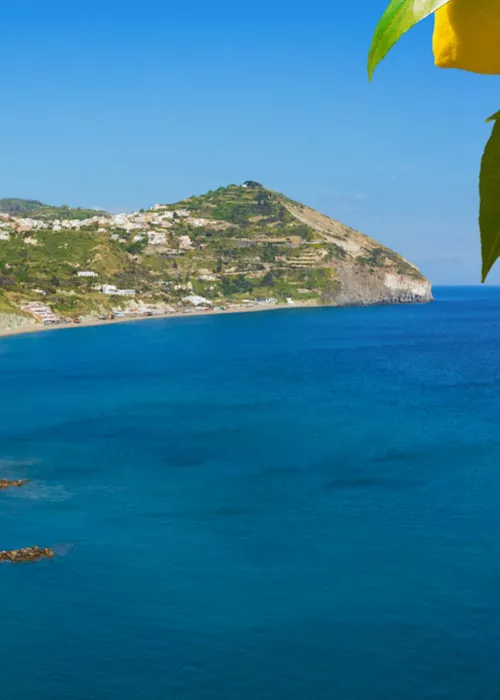
Le Fumarole: the steaming beach of Ischia, what a spectacle
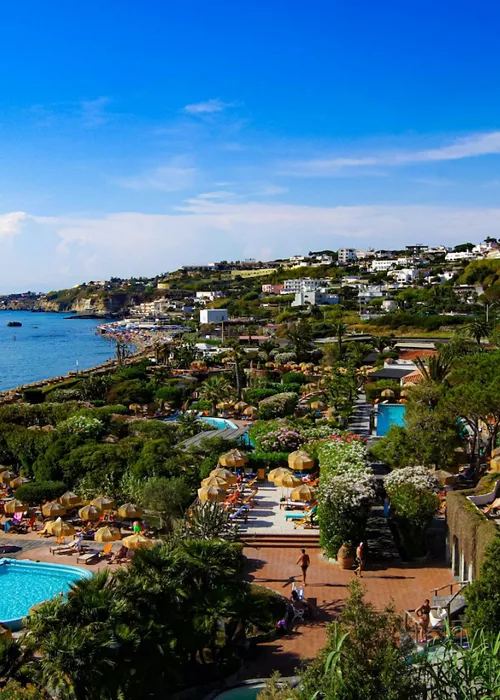
The Thermal Parks of Ischia

Street food in Naples is the quintessence of wonders for the palate

Continue living like an Italian
Subscribe to the Newsletter so as not to miss places, events and experiences for experiencing the best side of Italy: the authentic one.
Keep up to date
Would you like to learn about the most authentic experiences to be had in Italy, stay up to date on the most interesting events, discover our special offers and receive lots of insider hints and tips?
Save your favorite places
Create an account or log in to save your wishlist
Do you already have an account? Sign in
Herculaneum Tours

- See all photos
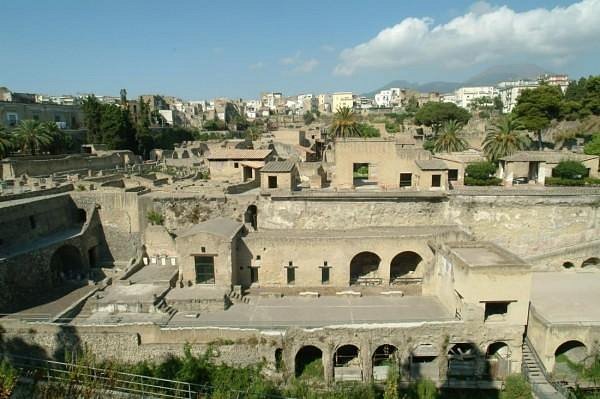
Skip the Line Ancient Herculaneum Walking Tour with Top Rated Guide

Skip-the-line Ancient Herculaneum Highlights Exclusive Tour with Private Guide

Skip-the-line Shore Excursion from Naples Cruise Port to Pompeii & Herculaneum

Herculaneum Guided Tour & Amalfi Coast Private Tour with Driver from Naples

Journey from the Herculaneum Ruins to the Mt. Vesuvius Private Tour from Naples
Most Recent: Reviews ordered by most recent publish date in descending order.
Detailed Reviews: Reviews ordered by recency and descriptiveness of user-identified themes such as wait time, length of visit, general tips, and location information.
Herculaneum Tours - All You Need to Know BEFORE You Go (2024)
- Pompeii - Mt. Vesuvius
Herculaneum Tours
Guided tours and day trips to Herculaneum with pick-up in Positano and Amalfi
Herculaneum is an archaeological treasure just as captivating as its larger and more famous neighbor Pompeii. Visit the ruins of this ancient Roman city with a tour or day trip from the Amalfi Coast. Book a tour that includes a guide and transfer, with or without a stop in Pompeii.
FAQ - Frequently asked questions
How long does it take to see herculaneum.
The ruins of Herculaneum are much smaller than those in Pompeii and can be explored in just a few hours. There is also more shade in Herculaneum than in Pompeii, so it's an ideal place to tour on a hot summer day.

Herculaneum guided tour with an Archaeologist
Walking tour – the tour lasts about 3 hours
As an archaeologist I consider the excavations of Herculaneum a unique, exceptional site. They are the most preserved Roman remains ever. You will visit a Roman city crystallized by a violent eruption of Vesuvius that occurred in the year AD. An exciting experience that will indelibly enrich your travel experience.
Herculaneum was an ancient Roman town located in the shadow of Mount Vesuvius, near present-day Naples in Italy. The history of Herculaneum is closely intertwined with the catastrophic eruption of Mount Vesuvius in 79 AD. Here’s an overview of its history:
Foundation and Early History : Herculaneum was founded by Greek colonists around the 7th century BC as a small coastal settlement known as Heraklion. Over time, it grew into a prosperous town, benefiting from its strategic location along trade routes and its fertile agricultural land.
Roman Period : In the 4st century BC, Herculaneum came under Roman control during the expansion of the Roman Republic. Under Roman rule, the town flourished as a resort destination for wealthy Romans, who built luxurious villas along the coast. Herculaneum became known for its opulent architecture, beautiful frescoes, and vibrant social life.
Mount Vesuvius Eruption : On August 24, 79 AD, Mount Vesuvius erupted catastrophically, burying Herculaneum and several other nearby towns, including Pompeii, under a thick layer of volcanic ash and debris. The eruption preserved the town remarkably well, providing invaluable insights into daily life in ancient Rome.
Rediscovery and Excavation : Like Pompeii, Herculaneum remained buried and largely forgotten for centuries after the eruption. Its rediscovery began in the 1710, when a farmer, digging a well in his land to find water, instead found the marble floor of the Roman theater stage. Excavations have been ongoing since then, revealing a wealth of archaeological treasures, including well-preserved buildings, artifacts, and skeletal remains.
Archaeological Site : Today, Herculaneum is an important archaeological site and UNESCO World Heritage Site. Visitors can explore the remarkably preserved ruins of the ancient town, including its streets, houses, public buildings, and even organic remains such as wooden furniture and foodstuffs preserved by the volcanic ash.
Insights into Ancient Life : The excavations at Herculaneum have provided scholars with invaluable insights into various aspects of ancient Roman life, including architecture, urban planning, social structure, economy, and daily routines. The well-preserved state of the town has made it a crucial site for understanding the Roman world and its inhabitants.
Overall, the history of Herculaneum is a testament to the power of nature and the resilience of human civilization. The town’s tragic fate and subsequent excavation have enriched our understanding of ancient history and continue to captivate visitors from around the world.
MEETING POINT + TOUR DURATION
Meeting Point Options: At the entrance of the Archaelogical Site of Herculaneum.
Duration: 3 hours
WHAT’S INCLUDED
- Guiding Service
Visit of the Ruins and of the local Musem
Herculaneum is an incredible ancient Roman city, smaller than Pompeii, but much better preserved. It was a rich city of the Empire that faced the center of the Gulf of Naples; many of his houses are superb and elegant, showing that many of his citizens had achieved good economic prosperity.
Herculaneum is located on the slopes of Vesuvius and for this reason, was completely buried by about 25 meters of pyroclastic materials of the terrible eruption of Vesuvius that occurred in A. D. 79.
Here you will see the incredible: wooden doors, windows, beds, other charred materials and the second floors of the houses. It is an extraordinary archaeological site that has a unique charm in the world.
During the guided tour of Herculaneum you are visiting: – The ancient beach – The scheletons – The house of the dears – A roman fast food – The house of the wodden partition – The Samnite House – The public bathhouse – The house of Neptune and Amphitrite – The decumanus maximus – The house of the bicentenary – The guild of the Augustales
ESTIMATED LOCAL CASH NEEDED
13 € – admission fees to enter in Herculaneum (the price is per person).
Under 18 years old are free of charge.
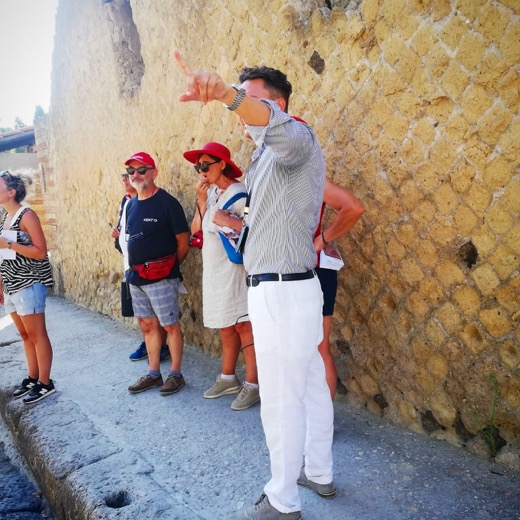
Herculaneum walking tour in 2 hours
Highlights walking tour
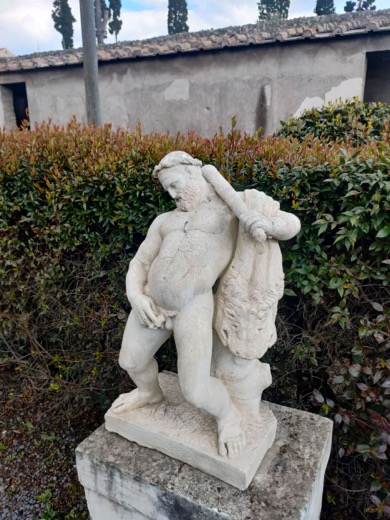
Herculaneum guided tour with private trasportation
Walking tour + taxi
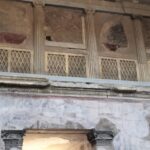
V iew Gallery
Check availability and book now
RELATED LINKS
On this page, major rome attractions, rome's best..., transport, tours & passes, outside rome.

- Rome hotels
- Venice hotels
- Florence hotels
- Naples hotels
- Pisa hotels
- Sorrento hotels
- Rome Fiumicino Airport
- Rome Ciampino Airport
- Venice Marco Polo Airport
- Pisa Airport
- Naples Airport
- Civitavechia (Rome) Cruise Port
- Naples Cruise Port
- Rome public transport
- Venice water bus (vaporetto)
- Florence public transport
- Naples public transport
- Sorrento local buses beyond Amalfi
Visiting Ercolano (Herculaneum) Italy
What to expect, tickets, and getting to ercolano (herculaneum).

Ercolano, known to many as Herculaneum, is just a few miles from Pompeii and 150 miles south of Rome, close to Naples.
In many respects Ercolano is a smaller version of Pompeii, both are buried Roman cities that have been remarkably preserved when excavated.
A lot of people prefer Ercolano to Pompeii as it is a much more compact site and has significantly less visitors.
Both sites are managed by the same people and it is easy to visit both in one day using a combined ticket and the local train which connects both.
Getting to Herculaneum What to expect at Ercolano Herculaneum tickets Herculaneum guided tour from Naples Ercolano private tour from Naples
Getting to Ercolano (Herculaneum) by public transport
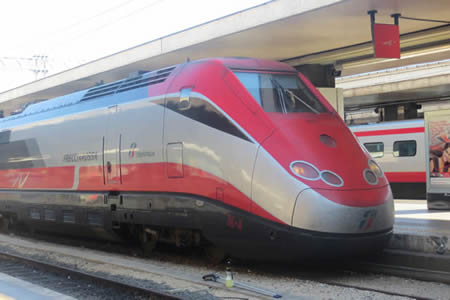
If you are not visiting on a tour then the best way to visit is probably the Circumvesuviana trains from Naples. This is a network of several lines in the Naples region, with Naples as the hub. The line to Ercolano goes from Naples to Sorrento and also stops at Pompeii.
If you are travelling from Rome , there are fast hi-speed trains that take around 70 minutes to Naples
Ercolano and Pompeii from Rome by train
There are two train stations called Ercolano, you want Ercolano Scavi.
Circumvesuviana trains from Naples go twice an hour between about 6am and 9.30pm Trains are very crowded, be prepared to have to stand for much of the journey.
Journey times are about 20 minutes to Naples and 50 minutes to Sorrento.
From the station entrance walk down the station approach road to a small roundabout style junction, cross straight over and down the main street directly opposite. Soon you'll get some reassuring signs so you know you are walking in the right direction.
Circumvesuviana trains - full details
Top of the page
Visiting ercolano - what to expect.
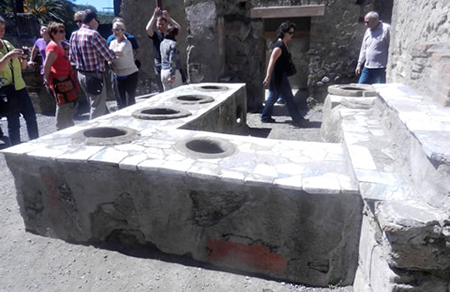
Ercolano is in the middle of the town of Ercolano. If you do not come on a tour bus walk from the local Circumvesuviana railway station, Ercolano Scavi, (more details further down the page).
Despite what the local touts may tell you its a 10 minute walk straight down the main street of Ercolano.
Ercolano opening times
Ercolano is open every day except Wednesdays, 25th December, 1st January and 1st May.
From 1st April to 31st October the site is open 8.30 - 7.30pm (with last entrance 6pm).
At other times the site is open 8.30 - 5:30 pm (with last entrance 3.30pm).
There are not the queues as at Pompeii mid-morning and there is no tourist tat village outside the gates.
Do I need a tour guide/ audio guide?
There is very little in the way of information within Ercolano describing what you are viewing.
If you want to make sense of what you are viewing you really do need a tour guide, an audio guide or a very good guide book. No audio guide is provided with admission.
For most independent visitors who want information about what they are seeing (recommended) the audio tours seem to be the most popular guide. You hire them at a separate kiosk after going the the ticket gate.
Once you leave the visitor facilities section, if you are not with a guide make sure you obtain a map of the site.
Facilities within Ercolano and at entrance gates
Facilities within the complex are basic, one small restaurant and cafe, rest room facilities, a bookshop/gift shop and that's about it. The restaurant and cafe often doesn't even bother opening, even when there are significant visitors.
This is not Disneyland, don't expect ice-cream stands and other commercial distractions scattered around the ruins.
The excavated town of Ercolano is well below the current level of the modern town. The entrance gates, ticket offices, gift shop, toilets, audio-guide kiosk and-restaurant are on the modern ground level and look down on the excavated city below.
The whole site is very exposed, only the ruins provide any shade, so it is imperative you bring lots of sunscreen, a hat and water.
Luggage and bags
Luggage or bags larger than 30x30x15cm are not allowed into Pompeii.
There is a cloakroom at the entrance gates where you can leave bags.
Ercolano (Herculaneum) tickets
You can order Pompeii tickets and tours to suit your needs in advance. No queueing and waiting, no foreign exchange issues.
Skip-the-line Herculaneum ruins ticket
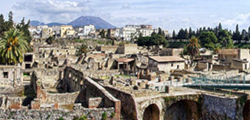
• Skip-the-line entry ticket to Herculaneum • Instant confirmation • Free cancellation • Option to present ticket on smartphone
Pompeii & Ercolano (Herculaneum) guided tour from Naples
For those who don't want the hassle of finding your own way and appreciate being informed on what you are witnessing, the stress free option is to simply take a tour that sets out from Naples with pick-ups at the cruise terminal and major hotels in Naples.
If you are coming from Rome by train, tours will pick-up from the Starhotels Terminus Hotel, a major hotel immediately outside the main entrance of Naples Centrale Station on your left.
Pompeii and Herculaneum day trip from Naples
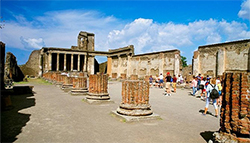
• Free hotel pickup and drop-off included • Led by a local guide • 3-course lunch included
Private tours to Pompeii & Ercolano (Herculaneum) from Naples
Using a local private car and driver is a very attractive option and for small groups can be very affordable too. For those coming from Rome you can be met at Centrale Station.
Your English speaking driver will meet n greet you at Naples Centrale Station and will ensure your trip encompasses exactly what you want to see at a pace set by you.
All vehicles are non smoking and fully air conditioned.
We offer three sizes of vehicle, for 1-3 people, 4 or 5 people and 6 to 8 people. Price is per vehicle not passenger.
After booking you pay a small deposit and receive a voucher through email. The remainder will be paid directly to the driver.
Private visit to Pompeii from Naples
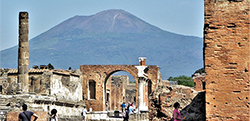
• Free hotel pickup and drop-off included • Led by a local guide • 3-course lunch included • Option to add on Herculaneum and/or Mount Vesuvius
Private Pompeii & Amalfi Coast tour
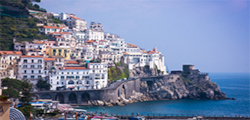
• Private round-trip transportation between Naples and Pompeii plus the Amalfi Coast • See Sorrento and Positano • Option to add on guide for Pompeii excavations
MOST POPULAR ROME TOURS 2024
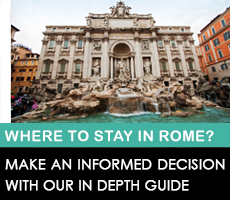

- Things to do
- Day Trips from Rome
Herculaneum
Located in the region of Campania, the town of Herculaneum suffered the same fate as Pompeii . The town was buried under Mount Vesuvius’s volcanic ashes and mud in 79 AD.
Hit before Pompeii, many inhabitants didn’t have time to escape and were engulfed in layers of debris, ashes and mud, dying instantly to be preserved for centuries.
What to see
At the foot of Mount Vesuvius, the city was the volcano’s first victim, and therefore the first wall of lava, ashes, debris and gases covered Herculaneum completely a little after midnight on 25 August. The previous day, it had been plunged in a cloud of debris leaving it without sunlight.
A UNESCO world heritage site , Herculaneum is better preserved than Pompeii . The city’s houses, baths, taverns, temples and figures are undamaged; therefore, visitors will get a real sense of the splendour of this Roman city.
Wealthier than its neighbouring Pompeii, the town is full of beautiful buildings. The different floors of most of the buildings are still intact and it is possible to see the magnificent frescoes and mosaics covering the walls of palaces, public buildings and mansions.
On the far side of the city are the most luxurious villas overlooking the sea, notably the Villa dei Papiri, which was the luxurious retreat of Julius Caesar’s father-in-law.
In Herculaneum, archaeologists have also found the first Roman preserved skeletons from the first century, since prior to this period Romans would cremate the dead. The skeletons are on display in one of the city’s houses.
Beautifully conserved
The town of Herculaneum has been magically conserved all these years . Objects like beds, and doors managed to remain under the layers of ash and mud without decaying.
Although it isn’t as well-known or as large as Pompeii , Herculaneum’s ruins are extremely impressive and gripping . Definitely worth visiting!
Today, the town of Ercolano lies extremely close to the ruins of Herculaneum, creating an interesting contrast.
Getting to Herculaneum
The most common ways of getting to Herculaneum from Rome are:
- Train : Visitors need to take a train to Naples to get to Herculaneum. These leave from Termini railway station. Once in Naples, the Circumvesuviana line goes to Herculaneum (Ercolano Scavi station). It takes between 2 – 3 hours to get there and the prices range from € 30 ( US$ 32.30) to € 100 ( US$ 107.70) for a roundtrip , depending on the train.
- Car rental : Although this is the cheapest option for families or groups of friends, you must keep in mind the price of petrol, parking and tolls. We would recommend this option only for those thinking of renting a car for additional days to visit other attractions nearby .
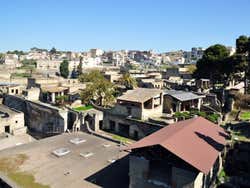
143 miles (230 km) south of Rome
1 November – 31 March: Every day from 8:30am – 5pm 1 April – 31 October: Every day 8:30am – 7:30pm
Adults: € 18 ( US$ 19.40) EU Citizens between 18 and 25 years old: € 5 ( US$ 5.40) EU Citizens under 18 years old and seniors over 65 years old: free admission
Nearby places
Pompeii (14.4 km)
You may also be interested in

Pompeii was an ancient Roman city near modern Naples that was buried by the great eruption of Mount Vesuvius in 79 AD.
Located in the Gulf of Naples, Capri is a dream-like island surrounded by a deep blue sea that reflects a very special light. Come and discover it.
Tips on Buying Tickets and Visiting Herculaneum near Pompeii and Naples
Published on May 17, 2024
by Henk Bekker
in Campania , Italy , N24 , NAdX , Naples
Buy tickets online, or use the Campania Arte card, and visit early morning or late afternoon for the best Herculaneum experience.
The best time to visit the Herculaneum excavations is early morning to buy the cheapest tickets onsite and to enjoy a pleasant quiet visit to the archaeological site in Ercolano near Pompeii and Naples. Online tickets and group tours also allow for skip-the-line entry.

The excavations of Herculaneum are usually less crowded than Pompeii but it is still sensible to arrive early in the morning, or late afternoon, when ticket queues are shorter and the site quieter. The cheapest tickets for the Herculaneum are sold onsite but the Campania Arte Card offers great savings too and allows for some skip-the-line benefits at busy times. Online tickets always have a slight surcharge but are sensible to assure priority entry on busy days. Specific timeslot reservations are currently in use. Guided tours and day trips are easy to book and often allow for seeing the excavations of Herculaneum and Pompeii on the same day. Admission is free for children under 18 and EU nationals over 65. Getting to Ercolano Scavi Vesuvio is easy as train transportation to Herculaneum is cheap and frequent from Naples.
2024: the train line to Herculaneum changed — many guidebooks still have outdated information.
Cheapest Tickets to Visit the Herculaneum Ruins
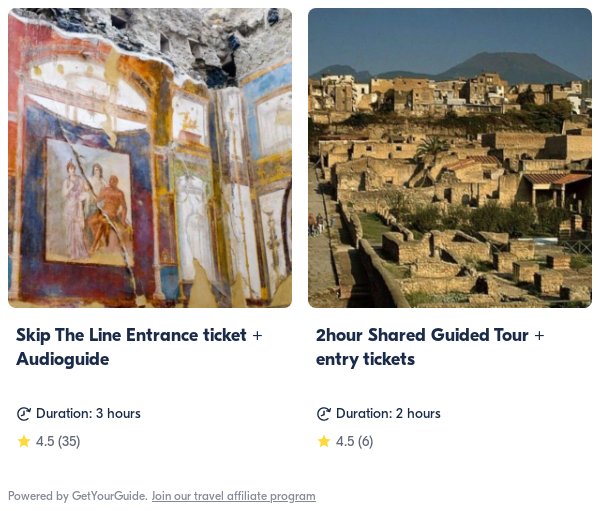
The cheapest tickets for the excavations of Herculaneum (Scavi di Ercolano) are sold at the ticket windows directly at the archaeological site. Arrive early at opening time, or buy online in advance — on busy days often worth the inevitable surcharge. Time-slot reservations are currently used at Herculaneum making it sensible to book in advance and also reserve a free time-slot if using a pass such as the Campania Arte card .
Basic admission tickets for the Herculaneum in 2024 are:
- €13 for adults
- €2 for young EU nations aged 18 to 24
- Free for all children under 18
- Free for EU nationals over 65
- Free for all on the first Sunday of the month (could be unpleasantly busy)
Most visitors to Herculaneum need to pick up a ticket at the ticket window, including exchanging online vouchers or mobile tickets at the priority access queue. However, an increasing number of QR codes may be scanned directly too. (A paper printout is sensible, especially if booking an audioguide.)
TIP: Pick up the map and information booklet at the information stand near the ticket window – the maps are not available once past the ticket checkpoint and re-entries are not allowed. These maps often run out — download a map or get a good guidebook before visiting if not planning on using an audio guide. (The official map and guide are available at the official Herculaneum website — search for “la miniguida degli Scavi di Ercolano”, or use Google translate and scroll down to the downloadable pdf files on the “ Informazione per la visita ” page. These maps and guides are available in several languages and far more comprehensive than the “mini” in the name might suggest!)
Herculaneum often does not operate a clear fast-lane skip-the-queue ticket window but visitors with online tickets or the Campania Arte Card (in 2024 only available as a mobile phone app) may go to the front of the queue – although booking a free time slot is even more sensible.
Priority entrance tickets to Herculaneum come at a price premium and may be worth it at busy times but are usually not required when arriving early morning, late afternoon, or outside the high season.
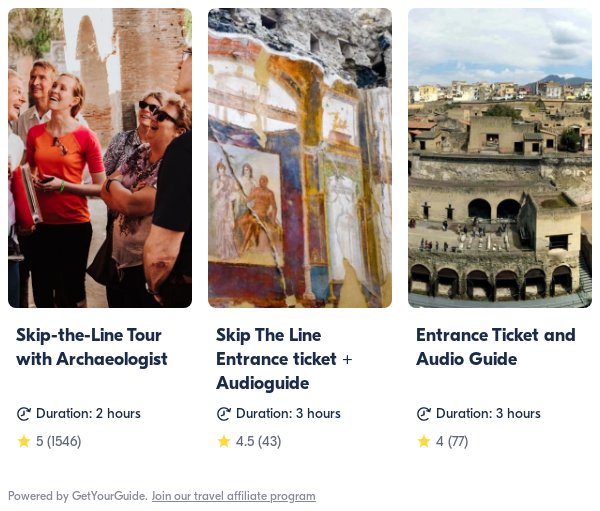
Excavations of Herculaneum Opening Hours
The Excavations of Herculaneum ( Scavi di Ercolano ) are open daily:
- mid-March to mid-October: 8:30 to 19:30
- mid-October to mid-March: 8:30 to 17:00
Last admissions are 90 minutes before closing but note that some sights are already closed long before the official closing time of the park. The archaeological area must be vacated around half an hour before the stated closing time.
The Excavations of Herculaneum are closed only on 1 January, 1 May, and 25 December.
The Herculaneum was closed on Wednesdays in recent years but is currently open every day of the week with 25 December and 1 January the only closed days.
Best Times to Visit the Excavations of Herculaneum
The best times to visit the excavations of the Herculaneum are early morning or late afternoon. Directly at opening time ticket queues are short and the site generally remains peaceful for at least the first hour.
Similarly, arriving around two hours before closing time will see the ruins either quiet or getting progressively more peaceful. The park is usually busiest between 11:00 and 14:00.
The archaeological site of Herculaneum is busier on weekends and during school holidays and best avoided on the first Sunday of each month when admission is gratis. (The number of visitors allowed in is more limited than at Pompeii.)
Also, try not to visit on Tuesday — smaller sights at Pompeii and some museums are currently closed on Tuesday and many disappointed travelers head to Herculaneum instead.
Tips on Visiting the Herculaneum Excavations

The excavations of Herculaneum are much smaller than Pompeii – visitors enjoy an overview of the complete site while walking from the main entrance gate to the ticket window. Around 40 houses are described – not all will be open. Information in the archaeological area is rather limited — take a good guide.
Guided tours to Herculaneum rarely exceed two hours and much less walking is required than at Pompeii.
Also in contrast to Pompeii, many buildings at Herculaneum have roofs making afternoon shade more common. Food and drinking options at Herculaneum are truly dismal and once off the modern paved area, no water or toilets are available in the excavated ruins area.
Day-Trips and Guided Tours to Herculaneum

It is easy to reach and explore Herculaneum alone but guided tours are available and a good guide certainly could add value by pointing out elements otherwise easily missed.
For families and small groups, a private tour may be sensible as it may even work out cheaper and has the benefit of not having to wait for others to take selfies, etc. Kids-friendly family tours are also available.
Pre-booked guides could sort out tickets in advance while available guides may advertise at the ticket windows for spontaneous bookings. As at other major Italian archaeological sites, all guides at Herculaneum are state-certified and thus knowledgeable and not making up the story as they go along.
Seeing Pompeii and Herculaneum on the Same Day
2024: the excavations of Pompeii and Herculaneum are no longer on the same train line making it more complicated and time-consuming to see these two popular sights on the same day when using public transportation (but a good option on guided tours ). Many guidebooks have outdated information and still list Ercolano-Scavi as a stop on all trains heading for Pompei Scavi (and Sorrento).
Trains from Naples to Pompeii or Herculaneum are frequent but the Ercolano-Scavi-Vesuvio and Pompei-Scavi-Villa-dei-Misteri stations are now on different lines. Travelers from Pompeii (or Sorrento) to the Herculaneum usually must change trains.
The following train options are available for travel between the Herculaneum and Pompeii archaeological sites:
- For travel between Ercolano-Scavi-Vesuvio and Pompei-Scavi-Villa-dei-Misteri (or Sorrento) stations, the expensive Campania Express trains remain an option but are realistically only available twice a day for sightseeing purposes. The more realistic option is the Circumvesuviana commuter train but except for early morning and evenings, a train change is now required. It is sometimes possible to change at Torre Annunziata-Oplonti station but often it is best to backtrack via Naples Garibaldi.
- A further option from Pompeii to Ercolano-Scavi station is to use the L4 Napoli-Poggiomarino Circumvesuviana commuter train from Pompei-Santuario station , which is a 5 to 10-minute walk from the Amphitheatre exit of the Pompeii archaeological site. This station is on the opposite side of the park from the Pompei-Scavi-Villa-Misteri station. Check maps and timetables in advance, as this is not the main tourist route.
Visiting both Pompeii and Herculaneum on the same day is tough on feet and legs but this largely depends on physical condition, the weather, and how extensively Pompeii is explored. It may be sensible to see Pompeii first -– Herculaneum requires far less walking and distances are shorter once inside the archaeological site.
However, given the ease of transportation, travelers staying in Naples may prefer to visit on separate days — Ercolano is only 20 minutes by train from Garibaldi station.
Many day trips from Naples and Sorrento combine Pompeii and Herculaneum on a single-day tour but be careful of too cheap tours that do not include admission or offer no guide at the archaeological sites. For small groups and families, it may be sensible – and often even cheaper – to book a private tour . Using public transportation and meeting the guide at Pompeii rather than in Napels also saves money.
Transportation to Herculaneum
Herculaneum is easily reached from the Ercolano station on the Circumvesuviana commuter train from Naples, Pompeii, or Sorrento. Traveling time is only 20 minutes from Napoli Garibaldi on at least twice-hourly trains but more complicated than previously if traveling from Pompei or Sorrento. See Transportation to Herculaneum for more details.
For More on Pompeii, Herculaneum, and Naples:
- Save with the Campania Arte Card on Sightseeing Ticket and Transportation — in 2024 only available as a mobile phone app — buy the Campania Arte Card online .
- Pompeii Excavations Archaeological Site: Top Tips on Visiting Pompeii , Buying Tickets and Booking Tours & Cheap Transportation to Pompeii . Note: New Pompeii Ticket system in 2024 !
- Herculaneum Archaeological Site (Ercolano): Tips on Buying Tickets and When to Visit & Cheap Transportation to Herculaneum (Note in 2024: trains have changed — many guidebooks still have old information!)
- Visit the National Museum of Archaeology in Naples – home to the Farnese sculptures and the best artworks, mosaics, and frescoes from the excavations of Pompeii and Herculaneum.
- Book Tours to Pompeii , Herculaneum , or both at Get Your Guide .
- Buy Italian train tickets in English at Trainline — however, often not possible for the commuter train to Ercolano or Pompeii — easy to buy at the station or use the Campania Arte Card .

About the author:
Henk Bekker
Henk Bekker is a freelance travel writer with over 20 years of experience writing online. He is particularly interested in history, art, and culture. He has lived most of his adult life in Germany, Switzerland, and Denmark. In addition to European-Traveler.com , he also owns a travel website on the Lake Geneva region of Switzerland and maintains statistical websites on car sales and classic car auction prices . Henk holds an MBA from Edinburgh Business School and an MSc in Development Finance from the University of London.

Home » Italy » Tips on Buying Tickets and Visiting Herculaneum near Pompeii and Naples
To provide the best experiences, we and our partners use technologies like cookies to store and/or access device information. Consenting to these technologies will allow us and our partners to process personal data such as browsing behavior or unique IDs on this site and show (non-) personalized ads. Not consenting or withdrawing consent, may adversely affect certain features and functions.
Click below to consent to the above or make granular choices. Your choices will be applied to this site only. You can change your settings at any time, including withdrawing your consent, by using the toggles on the Cookie Policy, or by clicking on the manage consent button at the bottom of the screen.
Amalfi Coast
Pompeii: plan, book, go.

Plan the perfect visit!

Visiting Pompeii
Guide to itineraries and sights

Visiting Herculaneum
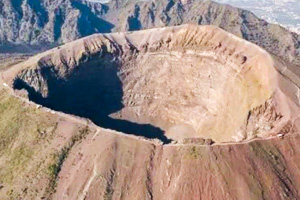
Visiting Mt. Vesuvius
Tips for planning a trip to the Vesuvius crater
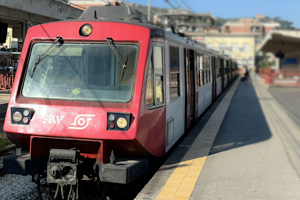
Getting here
Practical information on transport options
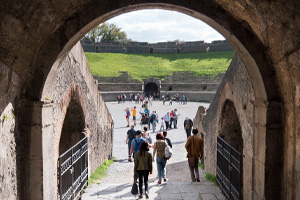
Tours and excursions
Book guided tours to Pompeii, Herculaneum, and Vesuvius

Frequently asked questions about Pompeii and the surrounding area

Naples-Pompeii train schedules
How to reach Pompeii and Herculaneum quickly and on a budget

Pompeii-Vesuvius bus schedules
Bus operating all year to get to the top of Vesuvius
Day trips from Sorrento, the Amalfi Coast, and Naples
Choose from our curated, vetted tours. Book now to reserve your spot!

Vineyard Cooking Class on Mt. Vesuvius
Free cancellation
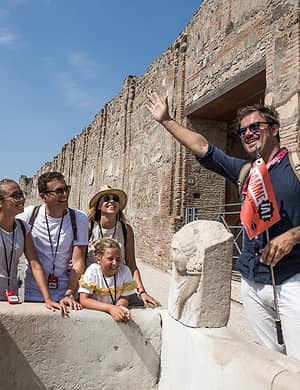
Skip-the-line Pompeii and Mount Vesuvius Guided Tour

Private Pompeii, Herculaneum, & Mt. Vesuvius Tour
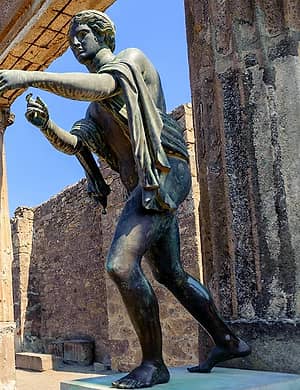
Tour of Pompei and Vesuvius from Sorrento, with pizza!

Pompeii, Herculaneum, and Mt. Vesuvius Tour

Pompeii & Herculaneum Group Tour from the Amalfi Coast

Herculaneum: Guided Tour Departing from Naples

Paestum and Mozzarella Private Tour
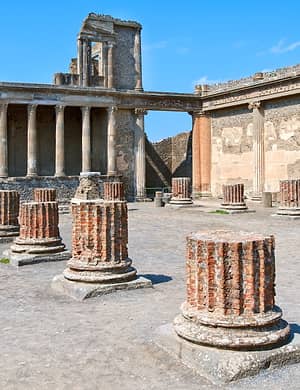
Pompeii, Vesuvius and Herculaneum Private Tour

Tour of Pompeii & Mt. Vesuvius from Naples by minibus
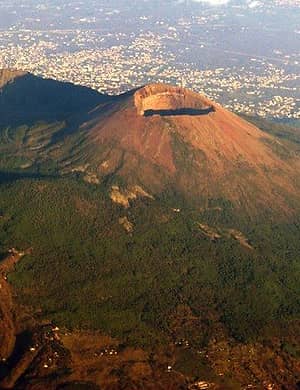
Pompeii Vesuvius Small Group Tour from the Amalfi Coast

Pompeii and Mt. Vesuvius Tour with Wine Tasting

Naples street food guided tour
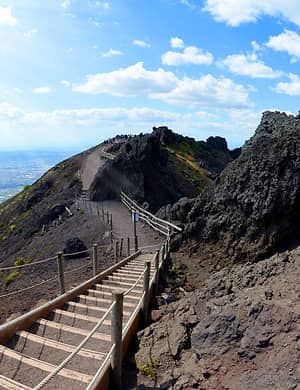
Mt. Vesuvius Tour with Wine Tasting - From Pompeii

Guided Tour of Naples: Historic Center and Underground
The essential guide to visiting pompeii, herculaneum, and mt. vesuvius.
Schedules, prices, skip-the-line tickets, guided tours, and top itineraries
Hours for Pompeii and Herculaneum
April to October : 9 am - 7 pm (last entry at 5:30 pm) November to March : 9 am - 5 pm (last entry at 3:30 pm) Closed : January 1, December 25
Herculaneum
March 16 to May 4 : 9:30 am - 7:30 pm (last entry at 6 pm) May 5 to October 14 : 8:30 am - 7:30 pm (last entry 6 pm) October 15 to March 15 : 8:30 am - 5 pm (last entry 3:30 pm) Closed : January 1, December 25
Tickets can be purchased at the ticket offices at the entrance to each site or through the online ticket office . Do not purchase tours or tickets from street vendors who may approach you at the Circumvesuviana train station!
Skip-the-line tickets to Pompeii
Skip-the-line tickets to Herculaneum
Prices / tickets
Pompeii ticket : Full price €18; discounted €2 Herculaneum ticket : Full price €13; discounted €2
Mastercard and Visa are accepted
Discounted tickets
Entrance is free to all EU citizens under 18. EU citizens under 24 have a special discount.
Luggage deposit
Backpacks or bags larger than 30x30x15 cm cannot be brought into either Herculaneum or Pompeii. The sites offer free baggage storage at the entrance, next to the ticket office.
Should I visit Pompeii or Herculaneum?
The biggest difference between Pompeii and Herculaneum is size: the ruins of Pompeii cover about 44 square hectares, while Herculaneum covers just four .
Pompeii was an important city and trade center , while Herculaneum was a small resort town without the large public buildings (forum, amphitheater, theaters, gym) found in Pompeii.
However, Herculaneum is in a much better state of preservation due to the deep layer of ash and dust that covered the site, which filled the buildings without damaging them. Pompeii was heavily battered by falling rocks and hot air that knocked down the upper floors of buildings and incinerated wood, both of which are still intact at Herculaneum.
All things considered, if you only have time to see one site, choose Pompeii . Herculaneum is a good alternative if you don't want to do too much walking or if the temperatures are particularly scorching, as it has more shade than Pompeii.
We do not recommend visiting Pompeii and Herculaneum in one day, as it is simply too tiring.
The ruins of Pompeii Recommended because: It's a unique example of a perfectly preserved Roman city with temples, theaters, homes, restaurants, and public buildings. It has more sites open to the public and a greater variety of architectural structures to visit. You can experience first hand the majesty of a Roman forum, theater, and amphitheater. Not recommended if: You only have an hour or two, as it takes a significant amount of time and energy to visit. It's a particularly hot day, as there is little shade. Visit Pompeii
The ruins of Herculaneum Recommended because: It's a small town that was a resort destination in ancient times, and can be visited in less that two hours. There are multi-story houses, wooden furnishings and decorations, and perfectly preserved mosaics and sculptures to admire. Not recommended if: You only have time to visit either Pompeii or Herculaneum; we do not recommend attempting both in one day. You want to explore it all, as many of the houses and buildings are not open to the public. Visit Herculaneum
Visiting the crater on Mt. Vesuvius
Combine a visit to pompeii or herculaneum with the mt. vesuvius national park.
Instead of attempting to see both Pompeii and Herculaneum in one day, we suggest a trip up to the crater at the peak of Mt. Vesuvius either before or after visiting one of the archaeological ruins. Wear sturdy shoes and clothes suitable for a short hike up the trail.
Getting from Pompeii to Mt. Vesuvius EAV bus : You can catch the local EAV bus from Piazza Anfiteatro and the Circumvesuviana station 'Pompei Villa dei Misteri.' The bus will drop you off at the upper bus parking lot on Mt. Vesuvius, where you can purchase tickets to the national park and take part in a guided mountain hike. Buses depart every 50 minutes; the ride takes about 55 minutes. Tickets can be purchased on board for €2.70.
Getting from Herculaneum to Mt. Vesuvius Vesuvio Express bus : This bus departs from the Circumvesuviana station 'Ercolano' and reaches 1,050 meters above sea level. From here you proceed on foot with a mountain guide, walking for about 20 minutes. Departures every 40 minutes, starting at 9:30 am. Tickets: €20 (includes bus + entrance to Mt. Vesuvius National Park)
Getting to Pompeii from Sorrento or Naples
The easiest way to reach the Pompeii ruins from Sorrento or Naples is via the Circumvesuviana train that runs between Sorrento and Naples. The train leaves from Piazza Garibaldi in Naples from the underground platforms of the Napoli Centrale station. From the ground-level platforms where high-speed trains arrive and depart, follow the signs downstairs to platform 3 where trains to Pompeii depart. Note the displays that list the next departing train for Sorrento - Pompei so you don't end up in Sarno!
Guide to visiting Pompeii
Guide to visiting Herculaneum
Guide to visiting Mt. Vesuvius
Download the PDF Guide (PDF 278 KB)
Getting to Pompeii and Herculaneum
Discover other destinations
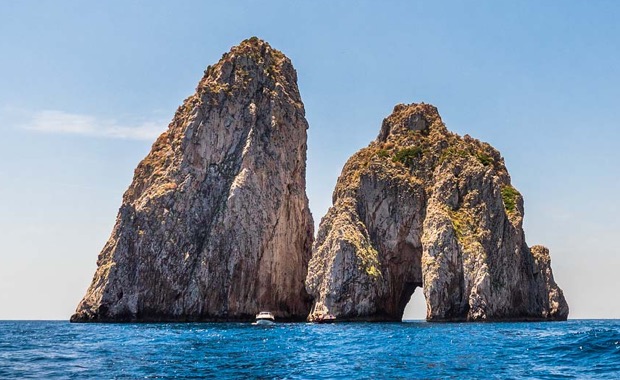
positano.com
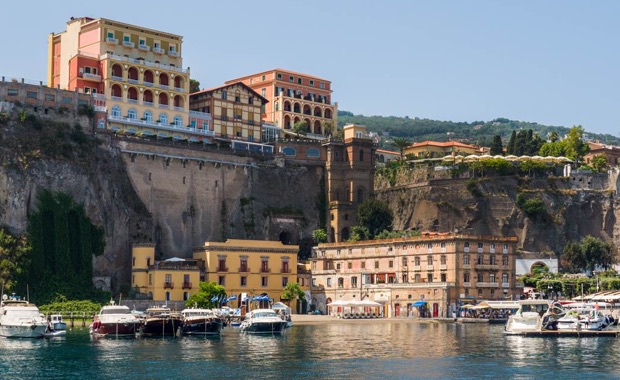
sorrentoinsider.com
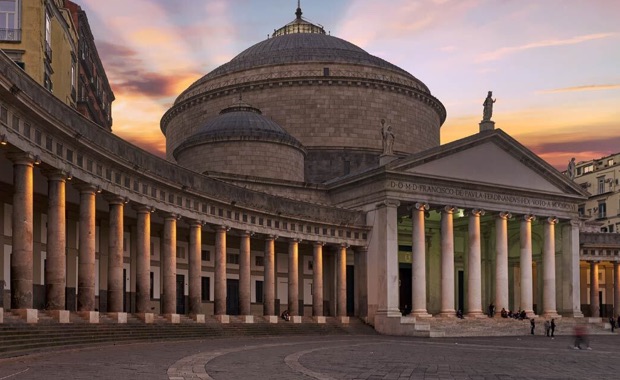
naplesinsider.com
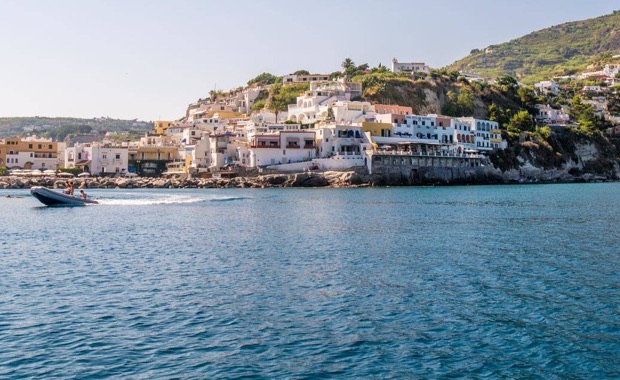
ischiainsider.com
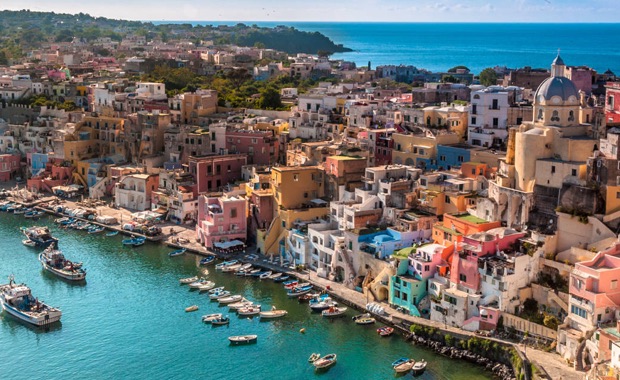
procidainsider.com

- Pompeii vs Herculaneum: Pros, Cons, How to Visit
In this guide to the great archaeological sites, we consider the big question of Pompeii vs Herculaneum . If you are trying to make the most out of your Italian vacation, you may be wondering if there is time to visit both ancient cities and perhaps even squeeze in a hike on Mount Vesuvius. Read on to learn where, and how to see one or both sites and why you’ll be glad you made the time to visit these astonishingly preserved ancient Italian cities.
What happened at Pompeii?
Why visit pompeii, how long do you need at pompeii, how to book the best tickets for pompeii, what to bring to pompeii, where can i stay overnight to visit pompeii, what happened to herculaneum, how long do you need at herculaneum, why visit herculaneum, how to book the best tickets for herculaneum, so, which is better: herculaneum or pompeii, best combined tours of herculaneum and pompeii, how to get to herculaneum and how to get to pompeii.
Depending on how much time you have to spend between Naples and Sorrento during your trip, you may have to choose between one historical site and another.
If you have only one day to visit the area, for example, it may prove to be too much to visit both Pompeii & Herculaneum. I would not visit both in one day – Pompeii is a very large, hot, and dusty site.
Here are some things to think about as you plan your trip to the Gulf of Naples and these Italian towns.
Where is Pompeii?
Long before it was covered in a blanket of pumice and ash, Pompeii served as a strategic trading post for the Oscans in the 8 th century BC. Over time, the settlement was occupied by the Greeks , Phoenicians, and ultimately the Romans.

This major Italian landmark now rests on the coastline between Naples in the north and the lovely Amalfi Coast town of Sorrento in the south.
After Mount Vesuvius erupted, the two-day volcanic explosion sent a relentless volley of pumice stones raining down over Pompeii, at least partially destroying many buildings.

Approximately 1,150 bodies have been discovered at the site as a result of the deluge, the few remaining citizens who were not able to evacuate in time.
After the two-day deluge, a haze lay over the Naples Gulf as nearly 6 meters (approximately 20 feet) of layered tephra settled over Pompeii, burying the ruins and bodies below.
There is a reason that the ruins of Pompeii are on so many itineraries – the extensive site allows you to see almost an entire city before it fell silent.

In walking the ancient, cobbled streets, it’s possible to spend hours exploring its many iconic and unique sites.
It also has more excavated public buildings than Herculaneum and of course, it includes the plaster casts that show the expressions on the faces of Pompeii residents as they died trying to outrun the lava.
The clever technique, invented in the 19th Century by Guiseppe Fiorelli, of pouring plaster into the indentations of volcanic ash, has become a large part of Pompeii’s attraction.
With such a large site, a guided tour can make the best use of time. You can make sure you don’t miss out on the major sites and you can cover the large city on foot in the most effective way (with the least walking!)
If your time is short, or if you are trying to see Pompeii and Herculaneum in one day, a tour of Pompeii is money well spent.
Many of the tours are by archaeologists, or you can choose one that suits your time frame and your pick-up and drop-off points.
To summarize some of the pros of visiting Pompeii:
- Much larger site than Herculaneum, with more buildings excavated
- Fewer tourists
- Better preserved
- Closer to Naples
- Takes less time to visit and so is better for visitors with limited time
- Beautiful frescos
- Plaster casts add a level of ‘reality’
Because of the extensive nature of the unearthed ruins at Pompeii, it is quite possible to make an entire day out of your visit. There are three suggested routes you can possibly take, each walking you past different sites.

It is worthwhile to get one of the professional tours offered inside the site for historical context or to book one of the excellent tours before you go.
The guides not only help you from getting lost but can really help to bring the ruins to life with their knowledge. Tours typically clock in around two hours, so in theory, this could make for a condensed visit in and of itself.
However, it is not possible to see all the noteworthy sites at Pompeii in two hours. For a full guide to the different walking itineraries and best tours of Pompeii, read Visiting Pompeii and Mt. Vesuvius: tickets, travel tips, tours, highlights.
Purchase your online downloadable electronic tickets online here, with the guarantee that you can cancel, completely freely, up to 24 hours before your entrance time.
There are two extremely popular entrance tickets to Pompeii with thousands of positive reviews:
1. Pompeii Reserved Entry Ticket
With over 5,200 reviews, this is the most popular entry ticket to Pompeii. The best features of this ticket are:
- Price – at only US$26 it’s a great price for the convenience of an electronic ticket
- Cancel for free with a 100% refund, no questions asked, up to 24 hours in advance
- Instant confirmation
- Download it onto your phone to show at the entrance gate or print your ticket
- The booking fee is included in the ticket, there are no other charges.
2. Pompeii: Fast Track Ticket Entrance with Audio Guide
With over 2000 reviews, this is my preferred ticket. It’s $6 more than the reserved entry ticket, but these tickets are Skip the Line tickets , meaning you will get into the site with the minimum time queueing.
The best features of the Fast Track Ticket Entrance are:
- Skip the Line ticket gives you priority entrance without queueing with the General Admission queues
- Price – at only US$31.90 it’s a great price for the convenience of a skip-the-line electronic ticket
- Audio Guide included with your ticket (however, it’s completely useless)
- The booking fee is included with the ticket, there are no other charges
If you are planning for a full-day affair, it’s best to bring packed lunches to be enjoyed at one of the several picnicking areas on site.

Otherwise, there is a small café serving snacks and light lunches to provide you with fuel to continue your explorations, but realistically, you’ll need to leave the site and cross the road to get to the few cafes and restaurants serving food.
Make sure you have sunscreen, a water bottle, and a cap. There are spigots along the routes for filling up water bottles, free of charge.
Closed-toed shoes are recommended, as the site is very dusty—sandals make for filthy feet at the end of the day!
While it is possible to stay as far away as Rome and still visit the archaeological sites of Herculaneum or Pompeii on a day trip, traveling by train to the sites takes several hours and may eat into a significant portion of your touring time.
As such, many folks prefer to stay in nearby Naples or the beautiful Sorrento as their home base during their travels, as it cuts down on time spent on the train en route to the conservation sites.
Less time commuting means more time exploring!
There is also a lovely, simple hotel right across from the Pompeii archaeological zone – the Hotel del Sole, Pompeii Ruins – You can have breakfast looking out over the ruins and that’s a pretty special occasion!
Where is Herculaneum?
While both Herculaneum and Pompeii fell as a result of the eruption of Mount Vesuvius, they both suffered relatively different fates.

Whereas Pompeii crumbled under a shower of pumice stones, Herculaneum is remarkably well-preserved.
Nestled against the base of Mt. Vesuvius near Naples, Herculaneum was a once richer city in comparison to Pompeii.
Frequently used as a vacation destination for the Roman elite, this port town was a hub for trading valuables and selling fine wares.
Today, few of the ruins have been excavated and are available for visitation. Much of the preserved city still lies beneath the modern city.
Conservation efforts are focused on preserving and elevating what has already been exposed for the public, however, rather than digging up more ruins.
After the initial violence of the eruption sent a barrage of stones toward Pompeii, Herculaneum was rapidly flooded with a surge of extremely hot, toxic pyroclastic gas.

Those who remained died instantly, some still clutching their coins and jewelry. They lay there until they were ‘discovered’ again in the 18th Century.
Because there are significantly fewer exhumed sites to see at Herculaneum, as much of the city still lies hidden underground, it can be done in two hours, maybe adding another hour for leisurely exploration.

Unlike Pompeii, Herculaneum does not have a food vendor on-site or a place to sit and eat a packed lunch.
Your best bet for food is along the walk from the train station to the entrance of the site, where you will find several cafes.
If you are, in fact, attempting to visit both Pompeii and Herculaneum in one day, a good strategy is to visit Pompeii first.
Take a guided tour for historical context and so that you have covered the most interesting parts of the site et lunch outside the ruins , then finish your day at Herculaneum.
It is important to note that these two sites share a grisly story—both are rife with human remains as those left behind attempted to protect themselves or flee.
While it is physically possible to visit both sites in one day, the gory background does carry some emotional weight.
There are some serious perks to visiting the Herculaneum ruins on what was the ancient shoreline of the Gulf of Naples. First of all, the crowds are significantly smaller.

This makes for a more intimate touring experience, and really allows the visitor to feel immersed in the eerily well-preserved buildings harkening to bygone Roman times.
The experience of visiting Herculaneum has been likened to that of stepping into a living museum, so it really is a one-of-a-kind place to visit while you’re in the area.
Herculaneum was covered in pyroclastic material from the eruption of Mount Vesuvius.
This is a different kind of volcanic material from the ash that covered Pompeii and it means that many more wooden and organic objects were carbonized and preserved.
So you can see doors roofs, beds, papyrus, and even food from 79 AD!
Whether you are interested in surviving tokens of Roman opulence or catching glimpses of human skeletal remains buried in stone in the ports at the edge of the town, Herculaneum is sure to transport you and capture your imagination.
To summarize just some of the pros of visiting Herculaneum:
- Amazing frescos
- More objects made from wood and also organic material has survived
- Feels like stepping into a living museum
There is really only one entrance ticket that is booked by thousands of people every year and it’s this one:
Herculaneum Priority Entry Ticket
The best features of this ticket are:
- Price – at only US$20 it’s a great price for the convenience of an electronic ticket
- Cancel for free with a 100% refund, no questions asked, up to 24 hours in advance
- Download it onto your phone to show at the entrance gate or print your ticket
- The booking fee is included in the ticket, there are no other charges.
CHECK AVAILABILITY: HERCULANEUM PRIORITY ENTRY TICKET
Which gets more tourists, Herculaneum or Pompeii?
Each UNESCO World Heritage Site not only has great historical relevance to Italy , but they differ in their size and their state of preservation. Pompeii and Herculaneum attract a different range of visitors.

Pompeii averages 3.5 million tourists a year, for example, whereas Herculaneum attracts around 300,000 visitors.
It may be that Pompeii attracts more visitors every year because it was the first of the two sites to be excavated, and because it is extensively so. As opposed to Herculaneum’s 16 or so sites to explore, Pompeii boasts over 100.
Because the exposed ruins at the Herculaneum conservation site are fewer than those of Pompeii, some visitors make the mistake of skipping this preserved city.

However, while Herculaneum may have fewer buildings unearthed, those that are on display are well worth a visit.
Due to the volcanic eruption’s relatively gentle interaction with Herculaneum, the ruins are spectacularly well-preserved – in fact, they’re at a better level of preservation than Pompeii.
Red paint can still be viewed on ancient columns as well as frescos, and even preserved food.
Two-story remains can still be seen, and many structures still have their roofs–unlike the ruins at Pompeii. The seafront area and the urban areas have good preservation, especially the upper floors.
Ancient Roman life is almost tangible in this eerily preserved place, and many visitors claim that it feels like stepping back in time.
If it’s the grisly aftermath of the violent eruption of Mount Vesuvius that you are after, don’t think the plaster body casts of Pompeii’s deceased citizens are the only sobering reminder of the natural disaster.
Herculaneum has hundreds of human skeletons in its port warehouses which were presumably attempting to flee by boat. Some of them have become rather famous, including the iconic “R ing Lady.”
And, because it’s less well known, Herculaneum is better to visit for those looking to avoid crowds. Especially for those with Covid concerns, this is a definite plus!
Comparing Pompeii to Herculaneum truly is an apples-to-oranges comparison. While both towns were decimated by the same event, their respective tombs are breathtakingly different.
If you can fit both destinations into your travels, it is worth the trip to do so!
And if you’re truly inspired to see the ancient sites that existed in this part of the world before the eruption of Mt. Vesuvius, it’s also worth fitting in a visit to Torre Annunziata to see the spectacular frescoes of Villa Oplontis
While there are car park areas relatively near both ancient towns of Herculaneum and Pompeii, many tourists choose to take the Circumvesuviana train from Naples or Sorrento to the two historical sites.

This saves headaches driving in a foreign country and finding parking. Taking the train also saves you taxi fare.
Unfortunately, tickets for the Circumvesuviana train cannot be purchased online, but you can easily purchase a ticket from a station in Naples or Sorrento for €3.60.
DEPARTING FROM SORRENTO
Simply get on the train from the city center and depart at Ercolano Scavi station for Herculaneum or Pompei Scavi-Villa dei Misteri station for Pompeii. Check out the schedule for the Circumvesuviana here .
If you’d like to be sure you’ve got a ticket and will arrive without any stress, purchase a Half-Day Herculaneum Express by Local Train ticket online before you leave home!
DEPARTING FROM NAPLES
While it is possible to hop aboard the Circumvesuviana at the Napoli Garibaldi station, this is a popular stop and has a tendency to fill up fast.
Stepping aboard the stop before at the Napoli Porta Nolana station ensures your spot on the train.
Arrive at Ercolano Scavi station for Herculaneum (just one or two stops away, depending on which station you depart from), and Pompei Scavi-Villa dei Misteri for Pompeii.
Keep Planning Your Trip to the Amalfi Coast
- Where to Stay in the Amalfi Coast (including Capri)
- 17 Best Things to Do in Ravello Italy in 2024
- 1 Day in Positano Itinerary 2024
- Visiting Pompeii and Mount Vesuvius: tickets, travel tips, tours, highlights [2024]
- Amalfi Coast Wedding – How To Plan Your Dreamy Destination Wedding
- Forum at Pompeii: Don’t miss these 6 sites!
- Herculaneum Ruins: How and Why to Visit in 2024
- 45 Best Landmarks in Italy to Visit in 2024
Monique Skidmore
Hi there, I’m Monique , an award-winning author & cultural anthropologist with a passion for ancient sites, culture, & wine. I’m passionate about Greece, Italy, & Cyprus travel, & divide my time between Australia & Europe. Read more here
Leave a Comment Cancel reply
- Naples Attractions
Herculaneum
House of Neptune
Samnite house.
- Frescoes and Mosaics
Villa of the Papyri
- Plan Your Visit
- Skip the Line Tours
- Guided Tours
- Herculaneum and Pompeii
- Audio Guide Tours
- Herculaneum and Vesuvius
- Pompeii Tickets & Tours
- Royal Palace of Naples
- Museo Di Capodimonte
Mount Vesuvius
- Villa Pignatelli
- Naples National Archaeological Museum
- Certosa di San Martino
- Catacombs of San Gennaro, Naples Tickets
- Città della Scienza
- Bourbon Tunnel
- Naples Underground
- Artecard Naples City Pass
- Veiled Christ
- Alibus Airport Transfers
- Castel Sant'Elmo
- Walking Tours
- Hop-On Hop-Off Tours
- Sightseeing Cruises
Herculaneum Tickets
Headout is an authorized and trusted partner of the venue, offering curated experiences to enjoy this attraction.

Herculaneum Skip-the-Line Guided Tour with Archaeologist
- You can cancel these tickets up to 24 hours before the experience begins and get a full refund.
- Get ready for an immersive and insightful tour of the ancient town of Herculaneum, along with skip-the-line access.
- Traverse this unique site on foot and pass along the monumental basilica, the grand spa complex, the gymnasium, and then some.
- Thanks to the expert archaeologist who will walk alongside you, you'll be privy to captivating anecdotes, secrets, stories, and chilling facts about Herculaneum.
- Most renowned for its Roman excavations, Herculaneum also has traces of Samnite, Greek, Etruscan influences.
- Learn all about the tragic effects of Mount Vesuvius's eruption, which mirrors its sister town of Pompeii.
- Guided tour of Herculaneum with skip-the-line entry
- Expert English, Spanish, French, German or Italian-speaking archaeologist guide
- Tip: Overlooking the Gulf of Naples in a dramatic fashion, this world-renowned town has much to offer, aesthetically speaking. Bring out your cameras for the panoramas!
- This experience is wheelchair and pram/stroller accessible. Entry is free for people with disabilities and an accompanying adult.
- Dogs are allowed into the venue, without restriction of breed or size. However, they must be kept with a leash and/or muzzle (the latter is obligatory for all breeds and opportunities provided by current regulations). Pet parents must have bags to collect any droppings.
- In the Antiquarium, inside the Padiglione della Barca and in the domus with mosaic floors, access is allowed only to dogs carried in their arms or in the appropriate carrier.
- Facilities: restroom, cloak room.

Herculaneum Skip-the-Line Tickets
- Swiftly enter Herculaneum, an ancient Roman town preserved better than Pompeii during the aftermath of Mt. Vesuvius’ eruption in 79 AD.
- Take advantage of your skip-the-line tickets into the UNESCO World Heritage Site, avoiding the long tourist lines to explore at your will.
- Upgrade to get 3D glasses and an audio guide for an augmented reality walking tour discovering the remnants of villas, bathhouses, frescoes, and more.
- Spend as much time as you want uncovering different homes, like the spaciously opulent House of the Bronze Hermes and the artisanal living space in the House of the Cloth.
- Skip-the-line entry to Herculaneum
- 3D glasses and audio guide (optional)
- Tip: Check out the unique House of the Skeleton, which has an atrium with shrines and a courtyard with a mosaic-covered altar.
- These tickets can't be cancelled or rescheduled.

Combo (Save 5%): Pompeii + Herculaneum Tickets
- Combine your visit to 2 ancient towns preserved under the ash of Mt. Vesuvius! Get tickets to the archaeological sites of Pompeii and Herculaneum.
- Bypass the queues at Herculaneum as you learn of its intellectual traditions at places like the Villa of Papyri, where 1st-century philosophy scrolls were found.
- Discover everyday objects at Pompeii, an amphitheater, public baths, and other sites that will give you a glimpse of the life of ancient Romans.
- The preserved UNESCO World Heritage Sites feature excavated ruins of streets and houses that you can freely explore.
- Entry to Pompeii
- Tip: Try to observe the different tiling trends in Pompeii and Herculaneum. While the former had colorful mosaics, the latter had more black and white designs.
- Big dogs (above the weight 10kg and the height of 40cm) are not allowed into the venue. Guide dogs with the proper certification are welcome.

Herculaneum Skip-the-Line Tickets with Audio Guide
- Want the freedom of self-discovery and the expertise of a guide as you visit Herculaneum? These skip-the-line tickets with an engaging audio guide have got you covered.
- In 5 languages, unravel the narratives of ordinary citizens woven into the colorful frescoes, intricate mosaics, and stunning structures.
- Explore the lavish House of the Deer and Villa of the Papyri, and walk along the ancient main street Decumanus Maximus, lined with shops and houses.
- Audio guide in Italian, English, French, Spanish & German
- Tip: Want to visit a supposed ancient cult temple rumored to be run by imperially-sanctioned freedmen? Stop by the College of Augustales.

From Pompeii/Naples: Pompeii, Herculaneum & Vesuvius Day Trip
- Experience a full day of adventure and history as you gain entry to Pompeii, Herculaneum, and Vesuvius National Park.
- Round-trip transfers from your hotel in either Pompeii or Naples, an expert driver, and a carefully curated route allow you to make the most of your trip.
- Benefit from a multilingual audio guide and map of Pompeii, followed by a visit to the homes and public spaces of the smaller city of Herculaneum.
- At Mount Vesuvius, you’ll climb to the active crater along with a volcanic guide, and find a thriving wine industry on its fertile slopes!
- Day trip to Pompeii, Herculaneum, and Vesuvius
- Round-trip transfers from Pompeii or Naples (as per option selected)
- Entry to Pompeii, Herculaneum, and Vesuvius National Park
- Audio guide and map of Pompeii
- Tip: Don’t miss Herculaneum's boathouses, holding the skeletal remains of those who tried to escape the eruption by sea.
- While Pompeii and Herculaneum are wheelchair and stroller accessible, the climb up Mount Vesuvius is not.
- Unfortunately, pets cannot tag along for this experience.

From Naples: Herculaneum Half-Day Tour
- Discover the ruins of Herculaneum, a well-preserved Roman town that suffered the same fate as Pompeii in 79 AD.
- See picturesque villas, bathhouses, frescoes, metal works, and more preserved in their near-perfect state in Herculaneum.
- Enjoy a comfortable experience with round-trip transfers from your hotel in Naples aboard a fully-fitted GT coach with audio commentary on board.
- 3-hour guided tour of Herculaneum
- Expert local guide
- Audio guides
- Round-trip transfers from Naples
- Fully-fitted GT coach
- Entry to Herculaneum
- During the low season, from Nov to Mar, the live guide inside the ruins will be replaced with an audio guide if the group is less than 6 people.
- The following are not allowed on this tour: Large baggage and suitcases.

Campania Express One-Way Tickets: Naples to/from Herculaneum
- Tired of travel hassles? Hop on board this one-way express transfer between Naples Porta Nolana or Porta Garibaldi station and Herculaneum Ercolano Scavi station!
- With train connections available every 3 hours, you won't miss a beat and zoom to your destination in just 18 minutes flat!
- Sit back, relax, and soak in the sights from vibrant city neighborhoods to the majestic Mount Vesuvius in the distance in air-conditioned coaches.
- At Herculaneum Ercolano Scavi Train Station, you've got options galore: heading further afield or exploring local gems, the station got you covered.
- One-way express transfers between Naples Porta Nolana or Porta Garibaldi train station and Herculaneum Ercolano Scavi train station
- Air-conditioning onboard
- Tip: First things first, grab a map at the Herculaneum Ercolano Scavi Train Station to navigate this ancient region and plan your day ahead.
- Please pay attention to the local displays and loudspeaker announcements and look out for trains having the name "Campania Express" on them.
Top things to do in Naples

Herculaneum | Vesuvius’ well-preserved victim
Buried alongside Pompeii in the catastrophic eruption of Mount Vesuvius in 79 AD, lies Herculaneum, a smaller yet more opulent Roman city. Unlike Pompeii , which was smothered by ash, Herculaneum was struck by a superheated pyroclastic surge, a scorching cloud acting as an insulator, essentially flash-baking the city and preserving a remarkable amount of organic material.
Even today, the remains of wooden furniture, doors, roofs, mosaics and frescoes, and even food have been remarkably preserved, offering a unique window into the daily lives of its wealthy residents. Visit Herculaneum in the Campania region of Italy and discover its amazing history.
Things to know before booking Herculaneum tickets
- Booking combo tours to both Herculaneum and Pompeii to understand the full aftermath of Vesuvius’ wrath makes sense. But don’t feel pressured to visit both sites on the same day. These tickets allow you to book entry to them on different dates.
- Besides Herculaneum and Pompeii, opt for the Artecard Campania to enter 5 top sites and grab discounts on several more! The Artecard Campania is valid for 7 days from the time of purchase.
- Purchasing skip-the-line tickets helps you save anywhere between 20 minutes to an hour’s worth of time , otherwise spent in long ticketing lines.
- Take a guided tour with a knowledgeable archeologist who can explain in detail the ins and outs of Herculaneum history , secrets, myths, and more.
- Short on time but don’t want to miss out? Ride the superfast Campania Express between Naples and Herculaneum in just 18 minutes! Note that this is a one-way ticket either from the Herculaneum Ercolano Scavi Train station to Naples Porta Nolana station or vice versa. Additionally, it doesn’t guarantee entry to Herculaneum; those tickets need to be purchased separately.
- Opt for the Artecard Campania to enter 5 sites , besides Pompeii and Herculaneum, like the Royal Palace of Caserta , the National Archaeological Museum of Naples , and Paestum for free, and grab discounts on several more! The Artecard Campania is valid for 7 days from the time of purchase.
- Those with mobility constraints/wheelchair users can avail of a specially designed route by informing the help desk at the beginning of the site.
- Herculaneum is the ultimate day trip destination , and you can book day trips with convenient transfers from Naples and Pompeii. In half a day, travel from Naples or Pompeii in an AC coach and visit both, Herculaneum and Mount Vesuvius.
- To learn more about the main reason behind Herculaneum — Mount Vesuvius itself, visit the volcano , hike up to its summit, peer into its craters, and know what makes it as famous as it is fearsome!
- Did you know that many of Herculaneum’s treasures are no longer housed in Herculaneum? Head to the National Archaeological Museum of Naples to see artifacts and items rescued from Herculaneum.
Your Herculaneum ticket types explained

Skip-the-line tickets
Suited for: Those short on time
What you get
- Breeze through the entry and meet your guide, or begin your exploration on your own without waiting for anyone.
- If you’ve booked a guided tour additionally, meet the archeologist who will whisk you away into the settlement’s folds and regale you with tales of majesty, heroism and heartbreak.

Guided tours
Suited for: History and culture enthusiasts
- Interesting history, anecdotes and trivia about the site from an expert local guide.
- If you're visiting Mount Vesuvius, benefit from a volcanic guide who will offer little-known facts and insights about these areas in an active volcanic belt.

Suited for: Those looking for an end-to-end package tour
- Round-trip options offer pick-up-and-drop from Naples/Pompeii, depending on your choosing.
- Within one full day, you can visit both Herculaneum, Mount Vesuvius and even Pompeii, depending on the ticket type.

Combo tickets
Suited for: Those who are seeking an in-depth experience
- Tick off other attractions on your Campania visit besides Herculaneum. Combo tickets offer better savings as compared to buying individual tickets.
- Include Pompeii and Mount Vesuvius in your itinerary to get a well-rounded understanding of the region, the consequences of the 79 AD eruption and more.
Booking guide: Find the best Herculaneum ticket for you
Herculaneum map and navigational guide.
The ruins at Herculaneum have several interesting attractions to visit, from ancient Roman houses to boat sheds and gymnasiums. Here's a map guide to getting around the ruins on your visit.
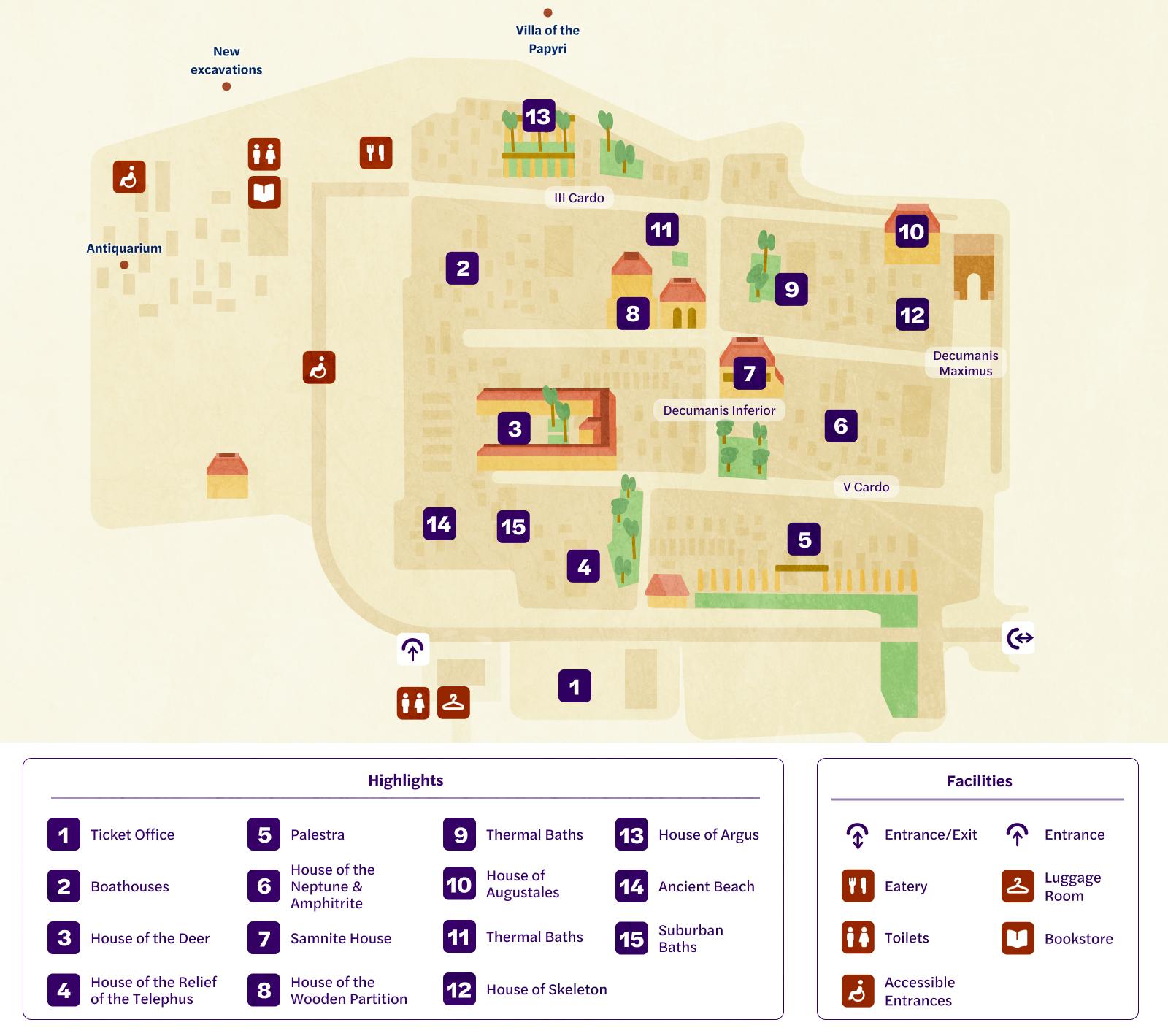
What to see inside Herculaneum

Located a little further from the House of the Charred Furniture, the House of Neptune was created as a tribute to the gods Neptune and Amphitrite. The primary attraction at the House of Neptune is a stunning glass mosaic wall featuring Neptune and his wife Amphitrite, with marble masks over it.
Considered one of the most magnificent villas in Herculaneum, this site gained fame due to the discovery of numerous papyrus scrolls that offer insights into the philosophical and intellectual rigor of the time. The Villa of the Papyri is thought to once have a vineyard and gardens, and has a direct view of the sea from its terraces.
Thermae (thermal baths)
The thermal baths date back to the 1st century BC and clearly demarcate separate areas for men and women. Once can still identify how the water was heated by a large, still-intact furnace.
Hall of the Augustales
Devotees of Emperor Augustus’ cult met here for their meetings and claimed it as their official seat. It is also identified by various frescos, famous ones portraying Hercules wrestling Achelous.
From all the excavation projects, the Samnite House was identified as one of the oldest aristocratic residences in Herculaneum. Of note is its beautiful flooring, rainwater pool and still-standing columns and pillars.
House of the Deer
On this spot, one can find another grand villa in Herculaneum, facing the oceanside. These were decorated with statues of deer and large marble tables that one can find in the on-site museum as well. Notice the unique flooring of this villa, as it is covered with intricate mosaics, frescoes and marble chips.
House of the Relief of Telephus
One of the largest buildings to have been excavated in Herculaneum, this house features a relief of Telepho, son of Hercules, being cured by Achilles. This residence is believed to be owned by Roman senator Marco Nonio Balbo.
It was in this boat house that some 300 skeletons were found. The remains are thought to be of people who sought to flee Vesuvius’ wrath by the sea, but the heat got to them before they could escape.
Plan your visit to Herculaneum

March 16 to October 14: 8:30am to 7:30pm. October 15 to March 15: 8:30am to 5pm.
Last admission: 90 minutes before closing time. Closed: January 1 and December 25.
Best time to visit: The best time to visit Herculaneum is in the morning (before 11am) or during the off-season, between October to April. This offers a more relaxed tour experience.

Address: Corso Resina, 187, 80056 Ercolano NA, Italy. Find On Map .
Getting there
By train: L1, L4 Nearest station: Ercolana Scavi By bus: ANM Nearest stop: Herculaneum By car: via A3, E45 Car parking: In addition to various private car parks in the area, the municipal car park in Viale dei Papiri Ercolanesi is operating regularly.

- Guests with motor disabilities can be assisted with the III Cardo ramp by reaching out to the staff at the entrance.
- There is an experimental app called Coloredibluerculanus that is available for children with Autism Spectrum Disorder. Interested visitors can email the site staff a week in advance to use it.

- Audioguides
- Information desk

- Please carry a small backpack or a purse as large bags aren’t allowed.
- Children below the age of 12 must be accompanied by an adult at all times.
- Infants must be carried in a sling or baby carrier as it is difficult to handle strollers in the cobblestoned areas.
- During the opening hours of the park, be sure to experience the Pomegranate Garden inside the House of the Relief of Telephus. It’s also a good idea to visit Maiuri Park, designed by the archeologist who extensively headed Herculaneum’s excavation projects. This botanical oasis is a gateway to appreciating the Naples countryside.
- If you’re a book lover, look out for and be part of the book sharing exchange that usually happens at the entrance on Corso Resina.
- There aren't many eateries around, so it is best to carry snacks or food and have a picnic around the site.

- Pappamonte: Enjoy a delectable selection of salads, Italian favorites (like gnocchi and eggplant parmigiana) and seafood at Pappamonte, located 1.7 km away .
- Bistrot Italia: Great interiors and sumptuous food (try the porcini!) spanning seafood, desserts and more, Bistrot Italia is just 1.6 km away.
- Ristorante Vesum: Good food and good views, Ristorante Vesum has an array of local delicacies including a selection of Campania red wine. Vesum is also known for its seafood. Vesum is located 7.7 km away.

- Budget: Herculaneum Maison and Hotel ( 40 m away ), Ruins B&B ( 1 km away )
- Mid-range: Miglio D’Oro Park Hotel ( 290 m away ), Villa Signorini Events and Hotel ( 900 m )
- Luxury: Il San Cristoforo ( 3.3 km away ), Sisina Luxury Room ( 1.6 km away )

Pompeii, Herculaneum’s twin site, was also entombed by hot ash and pumice by the Vesuvius’ eruption in 79 AD, preserving the city's structures, artifacts, and even human remains. Unlike Herculaneum, however, the debris that coated Pompeii was far lesser, aiding easier excavation of its remains.
Location: 16 km away

Still a fire-breathing dragon, Vesuvius is an active volcano that has lost some steam over the years. Now no longer as deadly as it once was, small spurts of sulfur occasionally escape from its mellow peaks. Visit this geological site to get an insight into its terrain and character — and discover how it reduced the cities on its foothills to near ash.
Location: 12.9 km away

National Archeological Museum
The Naples National Archaeological Museum is one of the most important archaeological museums in the world, housing an unparalleled collection of artifacts from ancient Pompeii, Herculaneum, and other sites in southern Italy. Some noteworthy works include the Bronze Runners from Herculaneum’s Villa of the Papyri, erotic charms and phallic symbols salvaged from Pompeii.
Location: 19.2 km away
Frequently asked questions about Herculaneum tickets
You can expect to save 20 minutes to an hour of waiting time by booking priority access tickets. With these tickets, all you need to do is show your ticket at the entrance and begin your tour immediately.
Since Herculaneum is buried in historical wealth, walking the ruins with a tour guide or archeologist can help you understand the meaning and purpose of various houses, frescoes and mosaics and other remnants. So, paying the extra few bucks for a guided experience is absolutely worth it.
Although nothing quite tops a guided tour , you can still learn about the history and significance of the Herculaneum with audio guided tours like Herculaneum Skip-the-Line Tickets with Audio Guide . If you want to go the traditional route and explore on your own, make sure you do plenty of research before visiting so you can fully appreciate what you’re looking at.
Avail Herculaneum audio guide tours in Italian, English, French, Spanish and German.
Typically, those under 18 enter for free, as do members of the ICOM, people with disabilities and one companion, students and teachers enrolled in courses related to archeology, culture, history, conservation, etc. Groups, Ministry bodies, etc. are liable to receive concessions.
It depends on the ticket you choose to book. While some tickets offer a full refund on canceling tickets up to 48-72 hours in advance, for others there may be no refund available on cancelation. Please check before you make your reservation.
Yes, entry is free for people with disabilities and one companion, provided they offer proof of availing social support.
Yes, tourists can generally access all sites open to visitors, unless any specific monument or building is cordoned off for repair, like the Villa of the Papyri , for instance.
While not exactly hidden, definitely check out the Palestra that sprawls two terraces (here, ancient Romans engaged in physical sport and ball games). Also visit the House of the Wooden Partition which has sliding doors that still work on their hinges. Though not much to look at, you can also stop by the House of the Skeleton, known for the fact that a skeleton was discovered here in the 19th century. It now has faded mosaics.
Yes, Herculaneum is a popular day trip destination owing to its proximity to Naples. From Naples or Pompeii, book transfers to Herculaneum. To tour Herculaneum from Naples, you need just 3 hours, including travel time. Additionally, along with Herculaneum, you can even visit Mount Vesuvius if your ticket permits.
Forget Password?
Do not have an account?
Already a member.

PRIVATE TOURS
Discover the ruins with our exceptional Guides
Custom Tours
Contact us to prepare your perfect itinerary
Shared Tours
Best small group tours with top rated guides
Skip the Line
book our tickets online and avoid the long queues
Free cancellation within 24 hours of booking
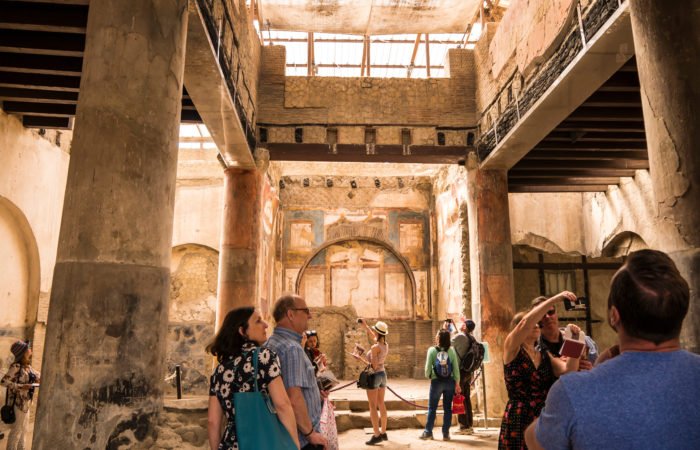
Herculaneum Small Group tour with an Archaeologist – Skip the line
Pompeii small-group tour with an Archaeologist and skip the line included
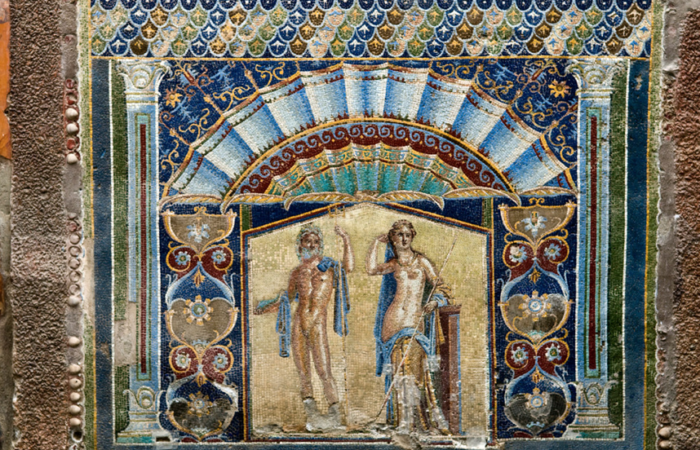
Herculaneum private walking tour

Pompeii private tour w/an Archaeologist/Skip the line
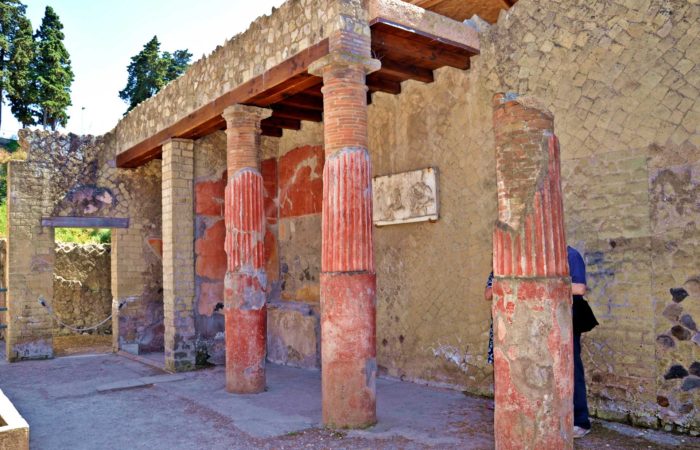
Pompeii and Herculaneum walking tour/Skip the line included

Pompeii and Herculaneum shore excursion
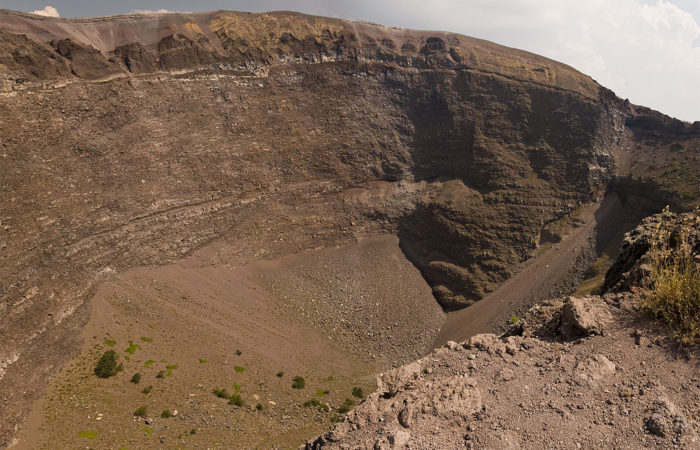
Herculaneum and Vesuvius – Private shore excursion

Pompeii and Vesuvius – Private shore excursion

Pompeii and Wine tasting at the foot of the volcano
Testimonials.

Why Book With Us?
Satisfied customers
live a unique experience with us
Award Winning
only the best certified guides
Secure Payment
secure payments with PayPal

- Terror Struck Aboard an Austrian Airlines Flight when Hail Damaged the Plane – See Photos » A commercial aircraft operated by Austrian Airlines en route from Palma, Majorca encountered severe hail damage during ...
- Incident Report: Murder of 11-year-old victim – Perpetrator previously released on parole for prior sexual offense » The acknowledged assailant involved in the tragic incident in Myrtia Ilia was granted provisional release pending further ...
- The journey of Christos Mastoras transforming into Stelios Kazantzidis unfolding the singer’s life story on the silver screen » Music, affection, familial bonds, companionship, nocturnal escapades, devoted supporters, and significant disputes intricately shape the tapestry of ...
- Boeotia: PYRKAL Fire Breaks Out Near Hazardous Material Warehouse » The fire isn't affecting the storage area; it's burning with low intensity amidst sparse vegetation ...
- Coldplay: Long queues form outside Herodion for the band’s music video » Earlier today, the production team issued a public invitation, many attendees are anticipated ...
- Pyrgos: An 11-year-old girl was found dead, stabbed in the neck with a screwdriver – a 37-year-old man is being investigated as a suspect (update) » The confessed killer had previously faced allegations of attempting to rape a minor. The child's mother had ...
- European Elections 2024 – Politico: Five Key Points Regarding the Ballot Box – Macron’s Challenge, Far-Right Surge, and the European Parliament » Key Takeaways following the European Elections - The Emerging Landscape in the European Parliament - From Le ...
- Pan-Hellenic University Entrance Exams 2024: Initial Estimates for the Cutoff Scores – Key Factors Include Mathematics and Greek Composition » 50% scored below average in Mathematics (2nd & 4th Field). Few scored above 15 in Greek ...
- European Elections 2024: Who is Galato Alexandraki from Eliniki Lysi political party » A woman never been involved in public affairs saw her name at the top of the party's ...
- Dutch tourist defaces ancient Roman villa in Herculaneum » Herculaneum, like Pompeii, was buried under volcanic ash during the eruption of Mount Vesuvius ...
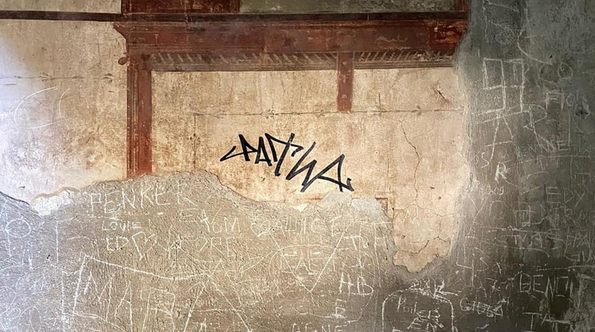
Dutch tourist defaces ancient Roman villa in Herculaneum
Herculaneum, like Pompeii, was buried under volcanic ash during the eruption of Mount Vesuvius
Related Stories

A 27-year-old tourist from the Netherlands has been accused of defacing a frescoed wall in the ancient Roman city of Herculaneum, located near Naples, Italy. The vandalism occurred at a historic site that has remarkably survived since the catastrophic eruption of Mount Vesuvius in 79 AD. This incident highlights ongoing issues with the preservation of world heritage sites amid increasing tourism.
The Herculaneum Archaeological Park, a site less frequented but equally as significant as its neighbor Pompeii , was the scene of the recent vandalism. Italian police reported that the tourist used a black, indelible marker to graffiti a section of a painted wall within the site. The man’s graffiti signature was promptly discovered by staff, leading to his swift identification and arrest.
Herculaneum , like Pompeii, was buried under volcanic ash during the eruption of Mount Vesuvius . However, the deeper layer of ash in Herculaneum has preserved the site’s ruins exceptionally well, making any damage to these ancient structures particularly grievous. The site is renowned for its detailed frescoes and mosaics that provide valuable insights into Roman life and art.
Radio signal from space repeats every hour, defying explanation
Italian Culture Minister Gennaro Sangiuliano condemned the act, emphasizing the importance of preserving cultural heritage. “Any damage hurts our heritage, our beauty, and our identity, and that is why it must be punished with the utmost firmness,” he stated, according to a CNN report .
Continue here: Ancient Origins

Mediterranean Cooking
- Φτιάχνουμε σπιτική βυσσινάδα, σκέτη γλύκα! Η βυσσινάδα, είναι το απόλυτο δροσιστικό ποτό του καλοκαιριού, γεμάτο γλύκα και φρουτένια γεύση
- The most delicious sticker pack has been created for the olivemagazine.gr community on Rakuten Viber Available for free at the Rakuten Viber Sticker Market from November 18th!
- Pasta with spetzofai sauce Spetzofai is a rustic spicy Greek dish that is made with thick sausages and long green and red peppers in a rich tomato sauce.
- Beef with peas and potatoes The perfect family meal is here with healthy peas and beef full of protein! Kids will surely love it… Serve with crusty bread! Serves: 4 Prep. time: 15′ Cooks in: 1:40′ Ready in: 1:55 Ingredients 1 kg beef flatiron 4 tbsp extra-virgin olive oil 1 garlic clove, finely chopped 1 tbsp tomato paste ½ cup […]
- Goji berry chocolate porridge A chocolaty goodness, an amazing comforting breakfast dish that the whole family will love! No added sugar, full of protein and chocolate!

- Coldplay: Long queues form outside Herodion for the band’s music video Jun, 10 2024

Terror Struck Aboard an Austrian Airlines Flight when Hail Damaged the Plane – See Photos
A commercial aircraft operated by Austrian Airlines en route from Palma, Majorca encountered severe hail damage during its descent toward Vienna on Sunday afternoon Read more →

Incident Report: Murder of 11-year-old victim – Perpetrator previously released on parole for prior sexual offense
The acknowledged assailant involved in the tragic incident in Myrtia Ilia was granted provisional release pending further legal proceedings associated with a prior sexual offense trial at the Court of Appeal Read more →

The journey of Christos Mastoras transforming into Stelios Kazantzidis unfolding the singer’s life story on the silver screen
Music, affection, familial bonds, companionship, nocturnal escapades, devoted supporters, and significant disputes intricately shape the tapestry of the renowned vocalist's existence Read more →
Dutch Tourist Accused of Defacing Ancient Roman Villa in Herculaneum

A sign made with a black marker by a tourist is pictured on the wall of a domus of the Herculaneum Archaeological Park, in Ercolano, Naples, Italy, in this handout picture obtained on June 3, 2024. Carabinieri/Handout via REUTERS
ROME (Reuters) -A Dutch tourist has defaced a frescoed wall in an ancient Roman house in Herculaneum, near Naples, damaging a building that survived the volcanic eruption of Mount Vesuvius in 79 AD, Italian police said on Monday.
The police statement said the 27-year-old tourist was swiftly identified after staff at the archaeological site discovered tagged graffiti writing made with a black, indelible marker pen on a white section of a painted wall.
Police said the writing was the man's graffiti signature.
"Any damage hurts our heritage, our beauty and our identity and that is why it must be punished with the utmost firmness," Italian Culture Minister Gennaro Sangiuliano said in a statement.
The tourist, who was not named, faces charges of damage and defacement of artistic works.
A smaller city than its more famous neighbour Pompeii, Herculaneum was buried under a deeper layer of ash, which protected its ruins from thieves and left particularly well-preserved remains.
It is not the first time that historical monuments have been vandalised by tourists in Italy.
Last year, a visitor from England was caught in a video, posted on social media, scratching his and his girlfriend's name with a key on an internal wall of Rome's Colosseum.
Also last year, graffiti artists scaled and tagged the soaring stone facade to Milan's Galleria Vittorio Emanuele II, the prestigious shopping arcade at the heart of the city. They were not caught.
In response to repeated acts of vandalism, Italy this year introduced tougher penalties on those who damage monuments and cultural sites, imposing fines of up to 40,000 euros ($43,548) for those found guilty of defacing monuments.
(Reporting by Matteo Negri, Editing by Crispian Balmer and Christina Fincher)
Copyright 2024 Thomson Reuters .
Photos You Should See - May 2024

Join the Conversation
Tags: Italy , art , Europe , Netherlands
America 2024

Healthiest Communities
Your trusted source for in-depth analysis on the issues impacting your community’s well-being delivered right to your inbox.
Sign in to manage your newsletters »
Sign up to receive the latest updates from U.S News & World Report and our trusted partners and sponsors. By clicking submit, you are agreeing to our Terms and Conditions & Privacy Policy .
You May Also Like
The 10 worst presidents.
U.S. News Staff Feb. 23, 2024

Cartoons on President Donald Trump
Feb. 1, 2017, at 1:24 p.m.

Photos: Obama Behind the Scenes
April 8, 2022

Photos: Who Supports Joe Biden?
March 11, 2020

Fed, Inflation to Dominate Economic News
Tim Smart June 10, 2024

What to Know About Joro Spiders
Cecelia Smith-Schoenwalder June 7, 2024

Takeaways From the Hunter Biden Case
Laura Mannweiler June 7, 2024

Trump’s Latest Campaign Pledge: Revenge
Lauren Camera June 7, 2024

Surprise! 272K Jobs Added in May
Tim Smart June 7, 2024

U.S. News Summit Focuses on Equity
Aneeta Mathur-Ashton June 6, 2024


Tourist defaces ancient Herculaneum frescoes, face steep, fine
T he Italian police reported a scandalous incident involving a tourist in Herculaneum. The man destroyed frescoes on the wall of an ancient house. He faces a hefty fine for this.
Herculaneum is a small town in the Campania region near Mount Vesuvius. Like the better-known Pompeii, it was buried under a thick layer of ash after the volcanic eruption in AD 79. Thanks to this , the ruins of the buildings from that time have been preserved to this day.
Tourist scribbles on the wall of an ancient villa with a marker
As you can see, even an ancient volcano could not damage the historic villa. However, a 27-year-old tourist managed to do so. The man scribbled on a section of the white-painted wall with an indelible black marker. It was his signature in the form of graffiti. The "surprise" was discovered by staff at the archaeological site, who immediately notified the police.
Police officers quickly identified the young vandal. The tourist will be charged with property damage and distortion of artistic works, and he faces a hefty fine for this.
Italy has increased the fine for acts of vandalism
In response to recurring acts of vandalism, Italian authorities have introduced stricter penalties this year for those who destroy monuments and cultural objects. A fine of up to €34,000 (approx. £29,000) can be imposed for property destruction.
– Any damage hurts our heritage, our beauty and our identity and that is why it must be punished with the utmost firmness – stated Italian Culture Minister Gennaro Sangiuliano in a statement.
Source: Independent
Capri's tourism crisis: Residents demand urgent intervention
Japan's tourism hits a historic high in March, with over 3 million visitors
Taylor Swift's European tour sparks travel boom for airlines


IMAGES
VIDEO
COMMENTS
Herculaneum has been preserved like no other site in the world, not even nearby Pompeii.The city was buried beneath 16 meters of ash and mud during the eruption of Mount Vesuvius in 79 AD, and this layer of detritus saved two-story domus homes with the internal architecture and décor intact, including features in wood and marble, decorations, jewelry, and even organic remains like food ...
It was on the other side of the furious volcanic explosion. Where Pompeii was covered by a 9 metre layer of porous pumice, Herculaneum's location saw it buried deep under a 20-25 metre mass of mud and pyroclastic flow, whilst the heat from volcanic gases carbonised wood, paper, bread, beds, and boats.
We've highlighted the top 12 attractions in Herculaneum that you shouldn't miss. For your convenience, we've included a self-guided Herculaneum walking tour on which you can see all the highlights of Herculaneum. The self-guided Herculaneum tour is 1.25 km (0.75 miles) long and takes about 1-2 hours at a moderate pace.
For these reasons, and because the site is smaller, less crowded, and the attractions are easier to explore, many tourists find visiting Herculaneum more interesting than Pompeii. The two ancient cities can be combined on a day tour from Naples, or Herculaneum is easily reached on a half-day trip from Sorrento.
Visiting Herculaneum from Sorrento. The journey from Sorrento to Herculaneum is another really easy trip on the Circumvesuviana train. Get on the train at the station in the centre of Sorrento and get off at Ercolano Scavi. The train from Sorrento to Ercolano takes around 40 minutes; at peak times there's a train every 15 minutes.
Corso Resina, 187, 80056 Ercolano NA, Italy. Phone +39 081 010 6490. Web Visit website. Herculaneum is an archeological zone located at the foot of Mount Vesuvius in the town of Ercolano in Southern Italy. Named after its patron deity, Herakleia (Hercules), the wealthy seaside town (along with its more famous neighbor, Pompeii) vanished beneath ...
Escape the city bustle on Naples for a tour of Herculaneum, a fascinating archeological site. Explore this ancient Roman town that was buried by a volcanic eruption in 79 A.D. with an archeological guide. See the site's thermal spas and striking mosaics. Pick-up in Naples and round-trip transportation are included.
A combined ticket costing €16 includes the entrance to the archaeological area and an underground visit to the Ancient Theatre of Herculaneum. However, the guided tours of the theatre are only available on Sundays at 10:00 (in English), 11:00 (in Italian) and 12:00 (in English) so it is suggested to purchase your ticket online here to ensure ...
Herculaneum History, traditions and daily life. Herculaneum, together with Pompeii and Oplontis, is part of the UNESCO World Heritage Site and perfect testimony of life in a typical Roman city. Founded according to legend by Hercules, it was buried by the eruption of Vesuvius in 79 A.D. Herculaneum attracts a great many visitors every year to ...
Herculaneum Guided Tour & Amalfi Coast Private Tour with Driver from Naples. 1. Historical Tours. 6+ hours. On this tour of Herculaneum you will walk through the moments of everyday life and to discover that world was not so different…. Free cancellation. from. $417. per adult.
The ruins of Herculaneum are much smaller than those in Pompeii and can be explored in just a few hours. There is also more shade in Herculaneum than in Pompeii, so it's an ideal place to tour on a hot summer day. Browse tours and day trips to Herculaneum available in 2024. Find information, prices, hours, and FAQ. Book in advance for the best ...
Roman Period: In the 4st century BC, Herculaneum came under Roman control during the expansion of the Roman Republic. Under Roman rule, the town flourished as a resort destination for wealthy Romans, who built luxurious villas along the coast. Herculaneum became known for its opulent architecture, beautiful frescoes, and vibrant social life.
Herculaneum: Skip-the-Line Tour with Archaeologist. This tour will take you on a guided visit of the world's best preserved Roman city, Herculaneum. This was a rich city of merchants and nobility, whose lives ended dramatically fast with the eruption of Mount Vesuvius nearly 2,000 years ago. See the waterfront, where the remains of more than ...
Ercolano opening times. Ercolano is open every day except Wednesdays, 25th December, 1st January and 1st May. From 1st April to 31st October the site is open 8.30 - 7.30pm (with last entrance 6pm). At other times the site is open 8.30 - 5:30 pm (with last entrance 3.30pm).
Train: Visitors need to take a train to Naples to get to Herculaneum. These leave from Termini railway station. Once in Naples, the Circumvesuviana line goes to Herculaneum (Ercolano Scavi station). It takes between 2 - 3 hours to get there and the prices range from € 30 ( US$ 32.50) to € 100 ( US$ 108.50) for a roundtrip, depending on ...
The ancient Roman city of Herculaneum is a UNESCO World Heritage site and lies just north of Pompeii. On this group tour, explore the ruins with an archaeologist guide and benefit from skip-the-line admission, meaning less time spent waiting around. Visit the Samnite house and the Temple of the Augustales, see the remains of the thermal baths and gymnasium, and learn how the city was destroyed ...
The best time to visit the Herculaneum excavations is early morning to buy the cheapest tickets onsite and to enjoy a pleasant quiet visit to the archaeological site in Ercolano near Pompeii and Naples. Online tickets and group tours also allow for skip-the-line entry. The excavations of Herculaneum are usually less crowded than Pompeii but it ...
Mount Vesuvius is the infamous volcano that destroyed Pompeii and Herculaneum in 79AD. It overlooks the Bay of Naples and is accessible from Ercolano via bus, train, or hike. Vesuvius is an active volcano that last erupted in 1944, however it's safe to visit and hike up or around it. It's clearly visible from Ercolano, so if you just want ...
To get to Herculaneum from Pompeii's Scavi station, hop on the train headed towards Naples. The ride is about 15 minutes and your station will be Ercolano Scavi (Herculaneum). You can also do the visit the other way round from Herculaneum to Pompeii. At Ercolano Scavi station take the train towards Sorrento and get off at Pompeii Scavi station.
Combine a visit to Pompeii or Herculaneum with the Mt. Vesuvius National Park! Instead of attempting to see both Pompeii and Herculaneum in one day, we suggest a trip up to the crater at the peak of Mt. Vesuvius either before or after visiting one of the archaeological ruins. Wear sturdy shoes and clothes suitable for a short hike up the trail.
Pompeii Reserved Entry Ticket. With over 5,200 reviews, this is the most popular entry ticket to Pompeii. The best features of this ticket are: Price - at only US$26 it's a great price for the convenience of an electronic ticket. Cancel for free with a 100% refund, no questions asked, up to 24 hours in advance.
Swiftly enter Herculaneum, an ancient Roman town preserved better than Pompeii during the aftermath of Mt. Vesuvius' eruption in 79 AD. Take advantage of your skip-the-line tickets into the UNESCO World Heritage Site, avoiding the long tourist lines to explore at your will.
We offer guided tours in the whole Italy with special interest for Herculaneum, Naples, Rome and other regions in the South of Italy for your best memories. +39 081 18368816 [email protected]
A 27-year-old tourist from the Netherlands has been accused of defacing a frescoed wall in the ancient Roman city of Herculaneum, located near Naples, Italy. The vandalism occurred at a historic ...
Carabinieri/Handout via REUTERS. ROME (Reuters) -A Dutch tourist has defaced a frescoed wall in an ancient Roman house in Herculaneum, near Naples, damaging a building that survived the volcanic ...
The Italian police reported a scandalous incident involving a tourist in Herculaneum. The man destroyed frescoes on the wall of an ancient house. He faces a hefty fine for this. Herculaneum is a ...
Early this year, the Italian parliament increased the fine for damaging a monument from 15,000 to 40,000 euros, NU.nl reports. A 27-year-old Dutch tourist is accused of defacing a wall in an ancient Roman villa in Herculaneum, an ancient city that was buried under lava along with the better-known Pompeii in 79 AD.
Archaeologists have unearthed an intricately decorated blue room, interpreted as an ancient Roman shrine known as a sacrarium, during recent excavations in central Pompeii in Italy.